Theme Parks & Themed Entertainment
From the JHM Archives — M – I – C in NYC : Disney at the 1964 New York World’s Fair

There has long been this legend about the importance the
1964 New York World's Fair played
in the history of the Walt Disney Company. How the Fair was supposed to be this
vital stepping-stone in the creation of Walt Disney World. How Walt had to see
if his theme park rides and attractions would meet with the approval of those
East Coast sophisticates before he'd agree to buy all that land around Orlando.
It's a nice story. Not true, mind you. But it's a nice story
nonetheless.
Truth be told, Disney operatives had already been scoping
out property around Florida for
at least three years prior to the Fair's opening in April of 1964. Indeed,
Disney's chief purchasing agent — a lawyer named Bob Foster — made a big
point of being seen publicly in New York
for the opening festivities for the '64 World's Fair just before he slipped off
to Orlando to pick up the options
on 12,400 acres of property.
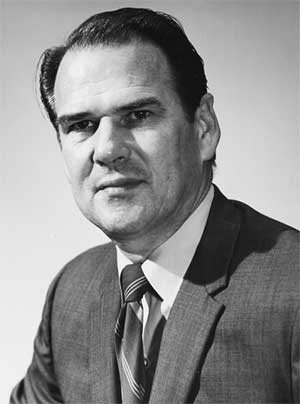
Robert Foster. Copyright Disney
Enterprises, Inc.
All rights reserved
Why for? Just in case someone in Florida
had recognized Bob and later asked him whether he'd been in Central
Florida doing the Mouse's bidding. Foster would then be able to
deny the accusation by saying "Wasn't me, pal. I wasn't in Florida
that week. I was in Flushing attending the Fair. I've
got witnesses."
So if the New York
World's Fair wasn't really the birthplace of Walt Disney World, then why do
Disneyana fans and theme park historians place so much emphasis and/or apply
such significance to the Fair?
The answer is simple, really. So much of the technology that
Disney developed to create the company's break-through theme park attractions
of the 1960s — "Pirates of the Caribbean," "The Haunted
Mansion," etc. — were a direct result of Walt Disney Productions'
involvement in the Fair.
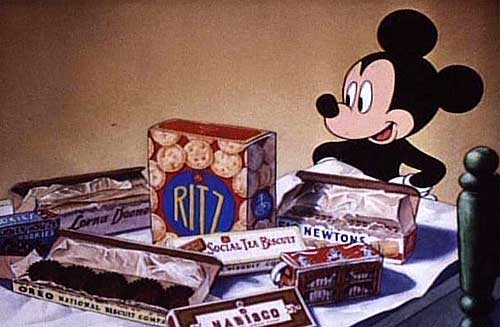
Copyright Disney Enterprises, Inc.
All rights reserved
Walt, having already created a few small exhibits for
earlier versions of the World's Fair (the 1939 New York World's Fair even
featured a special Mickey Mouse cartoon — "Mickey's Surprise Party"
— that Walt personally put into production promoting the product line of the
National Biscuit Company, AKA Nabisco), was already well aware of the
opportunities that an exhibition like this would offer to a company like
Disney.
Don't believe me? Then take a gander at this transcript from
a March 1960 meeting at WED Enterprises, where Walt tells his Imagineers about
the opportunities that he sees in the recent announcement that there's another
World's Fair held in New York in 1964:
"There's
going to be a big fair in New York.
All of the big corporations in the country are going to spend a hell of a lot
of money building exhibits there. They don't know what thy want to do. They
don't even know why they're doing it, except that the other corporations are
doing it and they need to keep up with the Jones. Now they're all going to want
something that will make them stand out from the others, and that's the kind of
service we can offer them. We've proved we can do it with Disneyland.
This is a great opportunity for us to grow. We can use their financing to
develop a lot of technology that will help us in the future. And we'll be
getting new attractions for Disneyland, too. That will
appeal to them. We can say that they'll be getting shows that won't be seen for
two six month periods at the Fair. These shows can go on for five to ten years
at Disneyland."
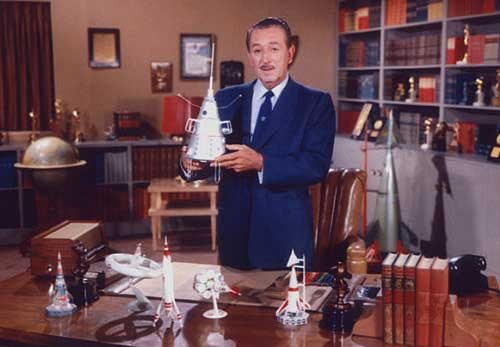
Copyright Disney Enterprises,
Inc. All rights reserved
You see? Walt saw the New York
World's Fair not so much as a chance to show off what his Imagineers were
capable of, but more as a tremendous business opportunity. A way to connect
with many of the corporate leaders of America
by helping them develop entertaining attractions that would properly showcase
their products at the Fair. Disney also saw the Fair as a means to an end, a
way to move some of his company's highly expensive dreams off the drawing board.
Take – for example – Disneyland's
"Enchanted Tiki Room" attraction. Now keep in mind that this was back
in the early 1960s, a time when the Walt Disney Productions was just beginning
to experiment with audio animatronics. Walt desperately wanted to put this
feathered floorshow into his Anaheim
theme park.
But the guy who actually held the company's purse strings –
Walt's brother, Roy – was reluctant to free up the millions that would be
necessary to build a full-sized version of this then-cutting edge robotic show
for Disneyland.
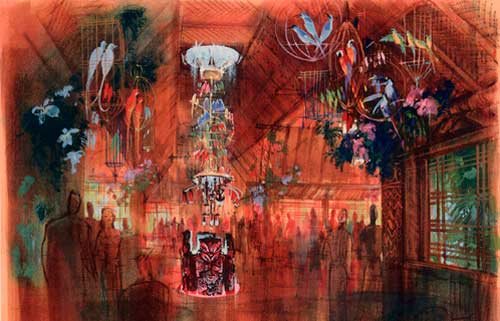
Copyright Disney Enterprises,
Inc. All rights reserved
That's when Walt had a brainstorm. He'd agree to build the
Tiki attraction for some poor company that was desperate to find a show to
present inside their pavilion at the 1964 New York
World's Fair. Disney would then make sure that his company's lawyers worked the
terms of the contract with this other corporation so that A) the pavilion's
sponsor would fully underwrite construction of the Tiki attraction and B) once
the fair was over, the Enchanted Tiki Room would automatically be shipped back
to Anaheim and begin presenting performances there. That way, Disneyland
would get a brand new high tech attraction without the Walt Disney Company
having to layout big bucks to build the thing.
It's an ingenious sounding scheme, isn't it? And here's the
intriguing part: It almost worked. Walt Disney Productions and Coca-Cola spent
most of 1962 going back and forth about whether the cola giant would underwrite
the cost of creating an Enchanted Tiki Room attraction that would be presented
as the centerpiece attraction at the company's pavilion at the 1964 New
York World's Fair. In the end, the folks back in Atlanta
decided that the price that Walt was asking was just too high. Which is why
Coke opted to take a pass on Disney's feathered friends.
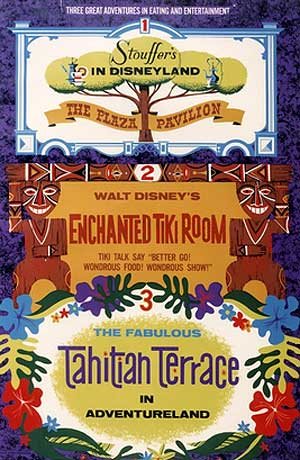
Copyright Disney Enterprises,
Inc. All rights reserved
Walt then supposedly tried to interest both the Gas Industry
and GM in including the Tiki Birds as part of the entertainment offered at
their World's Fair Pavilion. When these two companies also passed on the
project, Walt decided to bite the bullet and have Walt Disney Productions pick
up most of the cost of creating Disneyland's Enchanted
Tiki Room. With a slight financial assist from Stouffers Foods, the
Adventureland attraction opened in June of 1963 to great acclaim.
Speaking of GM, the real reason that the auto making giant
opted not to go with Walt's Enchanted Tiki Room (or any other attraction ideas
that the Mouse has put forward) is that — while the corporation had been
negotiating with Disney — it had also been forming its own in-house World's
Fair exhibit committee. So in the end, the carmaker felt that they didn't
really need Mickey's help to make a big splash at the 1964 World's Fair.
But — as they closed out negotiations with Disney in late
1960 — GM officials reportedly jokingly remarked: "You know who you
should really be talking to, Walt? The folks over at Ford. We hear that they
don't know what the hell they're going to do when it comes to the Fair."

Copyright Disney Enterprises,
Inc. All rights reserved
This — as it turns out — was indeed the case. Which was
why Ford jumped at the chance of having Disney create an exhibit for their
company to display at the 1964 World's Fair. By July 1961, the Imagineers were
already on site in Dearborn, Michigan
looking for ideas that they could possibly use in Ford's Fair attraction.
Oddly enough, Disney didn't discover any concepts for
possible Fair attractions out of this particular trip to Michigan.
But what they did get was an idea for a new theme park ride system. Observing
how Ford started out with a half ton of molten metal, then moved that super hot
pile of steel along a half mile long assembly line, only to have a finished car
burped out at the other end of the factory, Veteran Imagineer John Hench
wondered … could this same technology be used to move people?
That trip to Dearborn
lead to the creation of Disney's Omnimover system — the very system that the
Mouse uses today to move millions of people each year through their "Haunted
Mansion" attractions as well
as along its PeopleMover system.

Copyright Disney Enterprises,
Inc. All rights reserved
Anyway … the first idea that Disney pitched to Ford was a
"Symphony of America" ride, which would have taken Fair visitors on a
simulated tour of the United States.
Guests would have sat in Ford vehicles as they rolled past elaborate
recreations of the Grand Canyon, the Everglades,
the Sequoias, etc. Ford rejected this idea outright. Why? Because — back in
those days — you didn't tour America
in a Ford. You saw "the U.S.A.
in your Chevrolet." So Ford didn't want to do anything that might
inadvertently helped its competition.
That's where the Dinosaur ride idea came from. Veteran
Imagineers Claude Coats, Marc Davis and Blaine Gibson were put in charge of the
Ford project and then told to get as far away from the "Symphony of
America" idea as possible. Which is why they decided to set the revamped
Ford attraction in the distant past.
The end result; The Ford Wonder Rotunda featuring the Magic
Skyway, which was a huge hit at the Fair. It was also a massive undertaking. At
275,000 square feet, Ford's show building was easily the largest structure
erected on Flushing Meadow. The 127 audio animatronic figures that lined the
Magic Skyway's ride track also made Ford's show one of the more technologically
complex shows presented at the Fair.

Walt Disney and Henry Ford II
inspect model of the Ford Wonder Rotunda.
Copyright Disney Enterprises, Inc.
All rights reserved
Indeed, Ford's Wonder Rotunda — with its ambitious size and
scale — could be considered the mother of such Disney mega-attractions as
"Pirates" and many of Epcot's original attractions like "World
of Motion" and "Horizons." And the dinosaurs featured in Epcot's
"Universe of Energy" should look very familiar to '64 World's Fair
fans. They are the exact same figures — down to the creatures' poses and
actions — that terrorized visitors to Flushing back in
'64 and '65. Minus a few minor cosmetic changes, of course.
This brings us to another Fair favorite: General Electric's
Carousel of Progress. Which, as it turns out, wasn't originally developed for
the Fair at all. The Carousel was actually envisioned as the centerpiece
attraction of a late 1950s expansion of Disneyland's Main
Street U.S.A.
area: Edison Square, a
whole new land that would have celebrated the era when America
was shifting over from gas street lamps to the electric light bulb for its
primary source of illumination.
However, back in 1958, when this show was first pitched for
the Anaheim theme park, the
attraction's trademark theater-go-round technology didn't exist yet. Which is
why Disney's Imagineers envisioned audiences getting up and walking from
theater to theater to view this six-act show.
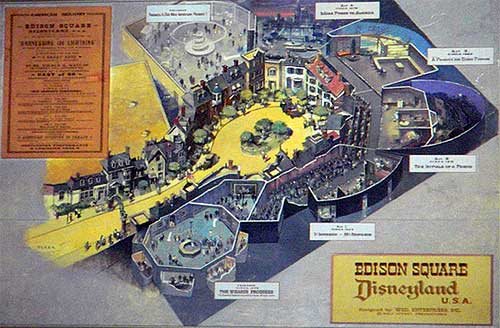
Copyright Disney Enterprises,
Inc. All rights reserved
By the way, this is the show that proves — beyond a shadow
of a doubt — that progress is always on the move. After closing in NYC back in
1965, this New York World's Fair
favorite moved to Anaheim where it
ran for several years. Then it was on to Orlando,
where Carousel has been entertaining visitors at Walt Disney World's Magic
Kingdom since the mid-1970s.
Speaking of shows that weren't originally created for the New
York World's Fair, let's now take a look at
"Great Moments with Mr. Lincoln." What's intriguing about this
attraction — particularly given that a significantly revamped version of
"Great Moments" just re-opened in Anaheim
to significant acclaim — is that this isn't the show that Walt really wanted
to do. "Great Moments with Mr. Lincoln" is a significantly stripped
down version of an attraction that Disney wanted to have debut at Disneyland:
"One Nation Under God."
This attraction was supposed to have been the centerpiece
attraction of yet another expansion of Disneyland's Main
Street U.S.A.
area: Liberty Street. This
proposed Anaheim addition was to
have celebrated America's
colonial period, featuring thirteen authentic period structures that were
supposed to represent the original thirteen American colonies.
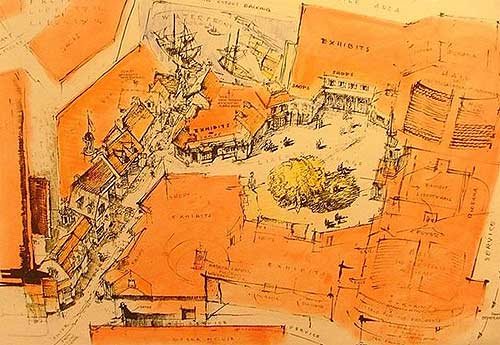
Copyright Disney Enterprises,
Inc. All rights reserved
The "One Nation Under God" show? Well, if you ever
saw the original version of Walt Disney World's Hall of Presidents, you've seen
"One Nation Under God." However, due to the huge cost of mounting
this particular production, Walt couldn't afford to produce this show all on
his own. Which is why he spent years trying to line up a corporate sponsor for
this super-patriotic show. Unfortunately, none of the companies that Disney
approached in the late 1950s / early 1960s bit on the high cost project.
Determined to finally line up a corporation to help
underwrite this proposed Disneyland attraction, Walt has
his Imagineers work up a full scale version of one figure from the show:
Abraham Lincoln. Walt hoped that — once potential sponsors got to see one of
these robotic presidents in the flesh (so to speak) — they'd immediately jump
at the chance to be associated with this show. Ever the showman, Walt had his
Imagineers set up a manually controlled version of the Lincoln
robot that could stand up and shake the hand of any potential sponsor.
Finally, the right man got the chance to shake Abe Lincoln's
hand: Fair President Robert Moses. Moses was said to be ecstatic when he
finally got to "meet" Mr. Lincoln, allegedly declaring that "I
won't open the Fair without this exhibit."

Copyright Disney Enterprises,
Inc. All rights reserved
The only problem was that — like Walt — Moses wanted the
big bells-and-whistles version of the show, "One Nation Under God."
So Robert personally began pursuing potential sponsors for the show. First off,
he went after the folks with the deepest pockets … the United States
Government. (The U.S. Government — after much hemming and hawing — had
finally agreed to put up $15 million toward the construction of a federal
exhibit for the 1964 New York World's Fair in early 1962.)
Moses appealed directly to the Department of Commerce, the
one office within the government with direct control over how the U.S.'s
money would be spent at the fair. He met personally with the undersecretary of
Commerce — Franklin Deleanor Roosevelt, Jr. — to try to get his office behind
"One Nation Under God" show. In the end, the U.S. Government —
though impressed with Disney's proposed presentation — felt that a show that
featured "talking doll" versions of our Commanders in Chief might be
viewed by some as being demeaning to the office of the President. So they opted
to pass on the project.
Now it's been suggested that FDR Jr. — who allegedly felt
that a robotic version of his dad would be extremely disrespectful —
personally put the kibosh on the Government picking up the tab for the
"One Nation Under God" show. Well, while I had heard this story from
literally dozens of former Disney Productions employees, no one's ever been
able to provide me with definitive proof on this matter. So — until that proof
turns up — I'm afraid that we're just going to have relegate the "FDR Jr.
killed 'Hall of Presidents' for the '64 World's Fair" story to the urban
legends pile.
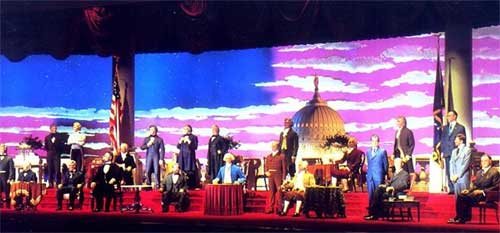
Copyright Disney Enterprises,
Inc. All rights reserved
Moses refused to give up, though. He kept pursuing potential
sponsors for the "One Nation Under God" / "Hall of Presidents"
show until December 1962. Robert even appealed to Coca-Cola, which — after
passing on presenting Disney's "Enchanted Tiki Room" — was still in
search of an attraction for the Fair. Hoping to finally close the deal with
Coke, Disney supposedly had the delicate Lincoln
figure shipped all the way from Burbank
to NYC to give a demo to Coke's CEO.
Unfortunately, the Chairman of Coca-Cola — while riding
into the city to see the Lincoln
demonstration — was supposedly insulted by a bunch of African-American
teenagers who were riding in an open car next to his limo. This supposedly put
the CEO in a foul mood that morning. Which — according to Robert Moses'
autobiography, "Public Works: A Dangerous Tale" — is the reason that
Coke ultimately decided to pass on sponsoring this project.
Things were looking pretty bleak for the electronic Honest
Abe until the state of Illinois
entered the picture. Illinois —
which didn't even get around to putting together the funding necessary sponsor
an attraction at the 1964 New York
World's Fair until early 1963 — was desperate to find some sort of show to
present at the Fair. Disney and Moses were desperate to find someone to sponsor
their "One Nation Under God" show. In one of those great "You've
got Peanut Butter in my Chocolate" moments, these three came together and
— Presto Change-o — Lincoln
finally had a sponsor.
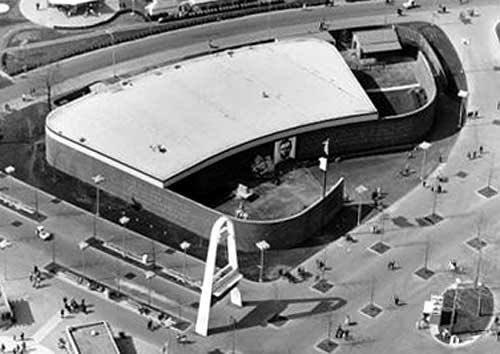
The Illinois "Land
of Lincoln" pavilion as seen
from above
Unfortunately, given the limited amount of prep time left
until the Fair opened, Abe would NOT be appearing alongside the other Chief
Executives. Why for? Because Disney just didn't have time to build AA versions
of all of the other Commanders in Chief. Which is why Lincoln
ended up doing a solo act — his "Great Moments with Mr. Lincoln"
show.
Of course, give that Disney got a late start on the
"Great Moments" show, it just makes sense that the robotic version of
our 16th president didn't debut with the rest of the Fair on April 20th. Due to
all the hassles associated with the rushed production, Lincoln
didn't officially open to the public until two weeks later, May 2, 1964.
As you probably already know, the finished version of
"Great Moments with Mr. Lincoln" was a complete smash. Walt was
proud, but not prouder than Moses — who had worked like a champ for nearly two
years to find Disney's remarkable Lincoln
figure a home at his Fair. How proud was Robert of this particular exhibit?
Years after the 1964 New York
World's Fair closed, Moses was often heard to say "My two greatest
accomplishments at the Fair were Michaelangelo's Pieta and Disney's Lincoln."
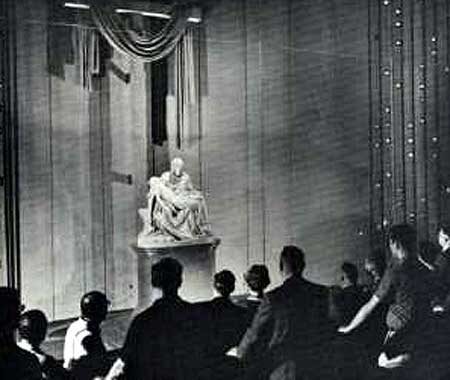
New York World's Fair visitors viewing the Pieta from the
Vatican Pavilion's moving walkway
But — at least from Walt's point of view — Walt Disney
Productions' greatest accomplishment at the Fair had to be its high-speed
creation of the "It's a Small World" ride. After all, this was a show
that no one thought would happen, let alone work.
You see, Pepsi-Cola was working with UNICEF — the United
Nation's Agency for Children's Welfare — to come up with an attraction for the
Fair that would salute UNICEF as well as pay tribute to all the children of the
world. After months of floundering, the creative staff at the cola giant
finally had to admit to management that they were stumped. They just couldn't
come up with a workable concept for a Unicef show for the Fair.
It was at this point that somebody finally said, "Let's
call Walt Disney." After all, given Walt Disney Productions' reputation
for turning out fine family entertainment, it just made sense to the folks at
Pepsi to approach Disney. After all, Walt and his staff were sure to be able to
find a way to make this UNICEF tribute show work.

Admiral Joe Fowler. Copyright Disney Enterprises,
Inc.
All rights reserved
The only problem is that Pepsi didn't approach Disney about
helping out with this project until April of 1963. Given the limited amount of
time until the Fair opened, head Imagineer Joe Fowler politely turned the cola
people away, explaining that there was just no way that Walt Disney Productions
could get a full-scale attraction for the Fair designed and built in the amount
of time that was left.
Which, as it turns out, was a mistake. When Walt got wind of
what Joe had done, he was furious. Disney called Fowler into his office and
basically read the man the riot act. "I'm the one who makes the decisions
around here," Walt allegedly roared. "So you call the Pepsi people
back now and tell them that we'll do their damned UNICEF pavilion."
Kind of ironic, isn't it? That the only reason that
"the Happiest Little Cruise That Ever Sailed " (or so says Disney's
own press releases) actually exists is that someone made the mistake of
upsetting Walt Disney.
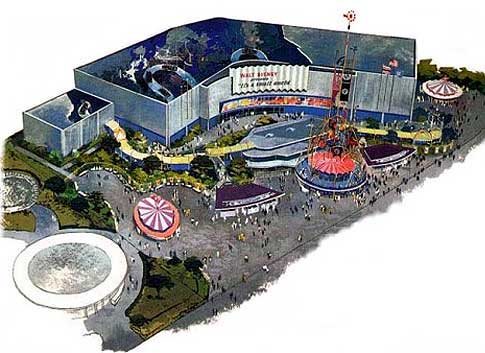
Copyright Disney Enterprises,
Inc. All rights reserved
Anywho … what's truly fascinating about the story of the
creation of Disney's "It's A Small World" is how much of what this
now beloved attraction is today was determined by how quickly the project was
slapped together. How so? Well, a lot of the layout and design of the finished
version of "Small World" was due to the fact that the Pepsi-Cola ride
building for this attraction was actually under construction before anyone knew
for sure what was going to go into the structure. That's why the folks at the
Fair just threw up a simple L shaped building with 32,000 square feet of space
inside. Those who actually worked on the attraction called it "the ugliest
building you ever saw in your life."
(Perhaps recognizing that the Pepsi-Cola building wasn't
what you'd call attractive, Walt Disney asked veteran Imagineer Rolly Crump to
come up with something to jazz up the front of the "small world"
structure. Distract people from seeing how boring the building really was. That's
when Rolly came up with the Tower of the Four Winds, a colorful but complex
array of mobiles that stood over the entrance to "Small World."
Which, in the end, proved to be a brilliant plan. Crump's mobile is now
remembered by many as one of the more charming things they saw while touring
the Fair. But almost no one remembers how boring the exterior of the Pepsi-Cola
building was. Anyway…)
It was until after the foundation had been poured and steel
was flying up that Walt decided that he wanted some sort of boat ride to run
through the Pepsi-Cola building. So — working with the L shaped boundaries of
the building — the Imagineers quickly roughed out a floor plan for a ride that
would pay tribute to all the children of the world. Only — in the original
version of the attraction — the children were all supposed to be singing the
national anthem of each of their individual countries.

Copyright Disney Enterprises,
Inc. All rights reserved
An early test on the Disney lot proved that this idea was a
complete disaster. All of the national anthems sung simultaneously meant that
the songs drowned each other out or — worse than that — bled together, making
this unholy noise. That's when Walt got the idea of grabbing the Sherman
Brothers — Bob and Dick — and asking them to do a song for the show.
Best known today as the Oscar winning composers of the score
for "Mary Poppins," the Sherman Brothers had already contributed
several songs for other Disney shows at the Fair. Remember "It's a Great
Big Beautiful Tomorrow" for G.E.'s Carousel of Progress? That was theirs.
Anyway, working off of Walt's instructions, Bob and Dick
quickly knocked out a roundelay, a song that could be sung as a round by the
robotic kids with an occasional counterpoint. Sticking a temporary title on the
tune of "It's a Small World After All," they dropped their first
draft of the song on Disney's desk — apologizing for the song being so silly
and simple. They promised their boss that they'd come back with something more
musically complex sometime later. Walt wouldn't hear of it. So the
thrown-together tune that the Sherman Brothers delivered to Walt Disney that
afternoon in late 1963 is the very same song that we can't get out of our heads
— no matter how hard we try — 50 years later.
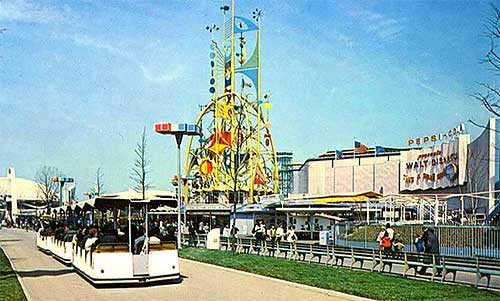
Copyright Disney Enterprises,
Inc. All rights reserved
Luckily, all of this hard work by Walt's Imagineers paid
off. All four of Disney's shows for the Fair received enormous acclaim. Indeed,
in some surveys that were taken to gauge the popularity of various shows and
attractions at the 1964 New York
World's Fair, Walt's shows often took four of the top five slots.
Attendance-wise, "Great Moments with Mr. Lincoln," "It's A Small
World," "Carousel of Progress" and "The Magic Skyway"
always made it into the top 15.
Of course, it's not like Disney didn't have a few
difficulties with its attractions during their days at the Fair. For example,
Mr. Lincoln had to have his glass eyes and false teeth repaired repeatedly. Why
for? Because some guests at the Fair became convinced that there was just no
way that this lifelike figure could be a robot. So — in an effort to prove
that Disney's Lincoln figure was
really just a guy in a suit — these folks used to whip the free ball bearings
that they'd pick up the SKF exhibit at the Honest Abe AA figure. Hence the
cracked eyeballs and the chipped false teeth.
The "Small World" attraction also had to deal with
periodic damage caused by pranksters. Not-so-nice New Yorkers were forever
stealing fish out of the Koi pond at the Japanese pavilion and slipping the
colorful creatures into the immense water-filled trough that ran through the
Pepsi-Cola show building. That is, of course, when they weren't emptying entire
bottles of Mr. Bubble into the water … which would result in the boats having
to push through 4-foot high walls of foam.
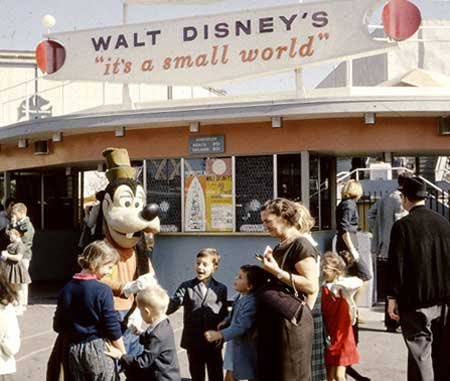
Copyright Disney Enterprises,
Inc. All rights reserved
Disney also wanted to have some of the company's rubberheads
– you know, those full-sized costume characters that regularly meet-n-greet
tourists at Disneyland and Walt Disney World – make
daily appearances in front of the Pepsi-Cola Building.
However, after Snow White had a switchblade pulled on her and Practical Pig had
his arm of his costume torn off, Disney's rubberheads suddenly began greeting
guests at the Fair from above – waving down at the people standing in line at
"It's A Small World" from a platform that was fixed to the
bottom-most portion of the Tower of the Four Winds.
True to his word, Walt tried to get all four of the exhibits
that Walt Disney Productions produced for the Fair brought back to Disneyland.
To that end, Disney was about 75% successful.
He got "Great Moments with Mr. Lincoln" and the
"Carousel of Progress" brought back to Anaheim
virtually unchanged. "It's A Small World?" Well, the ride made it
back to Disneyland … but not the Tower of the Four
Winds. As charming as this immense mobile might have been, Walt balked when he
learned about the projected cost of dismantling the tower and having it shipped
back to California.
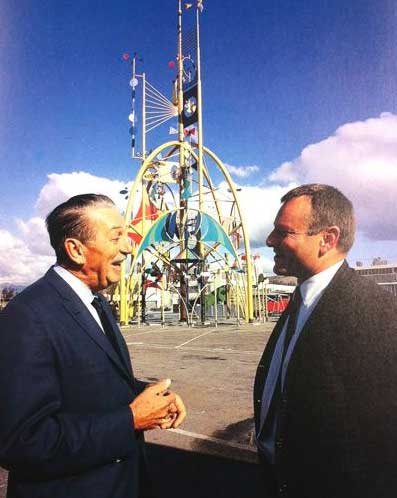
Walt Disney & Rolly Crump
with the Tower of the Four Winds in
Glendale,
before it was disassembled & sent to Flushing
Meadows. Copyright Disney
Enterprises, Inc.
All rights reserved
Which is why — after the Fair closed — the Tower of the
Four Winds was unceremoniously pulled down. The all-metal structure was chopped
into itty, bitty pieces using acetylene torches, then tossed into the Flushing
Rive The Tower's final resting place? I keep hearing that most of it ended just
offshore of the Fair's Lakeside Amusement area / Transportation Zone. Anyone up
for mounting an underwater salvage operation?
Ford's Magic Skyway? Well, given the size of the thing,
there was just no way that the entire attraction was going to make it back to Anaheim.
Walt settled for just the dinosaur AA figures, which he then tacked on the
park's "Grand Canyon" diorama as a trip
through the "Primeval World." This sequence has been serving as the
grand finale for the grand circle tour of Disneyland
aboard the park's steam locomotives for almost 35 years now.
Of course, these are the sorts of stories that any dedicated
Disneyana fan could already tell you about the company's involvement in the New
York World's Fair. But one of the more intriguing but
least well know aspects of Disney's tenure at the Fair was — after the 1964
season closed and the billion dollar extravaganza hadn't even come close to
meeting its attendance projections — Moses supposedly met with Walt and asked
for his help in driving up attendance for the 1965 season. Robert allegedly
proposed a new Disney-designed amusement area, which would have been built on a
large vacant piece of land next to the gas pavilion. Moses reportedly
envisioned a miniature Disneyland, complete with castle
and dark rides. Walt politely refused Robert's request.
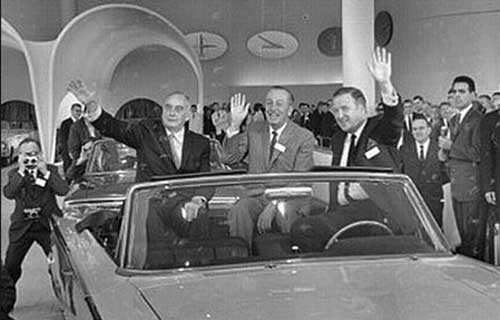
(L to R) Robert Moses, Walt
Disney & Henry Ford II at the grand opening of the Magic
Skyway at the Ford
Wonder Rotunda. Copyright Disney Enterprises, Inc.
All rights reserved
Why for? Well, maybe it was because Disney knew that Moses
was skating on thin ice at that point. As 1965 and the Fair continued to fall
behind its financial projections, a movement was started to oust Moses as head
of the Fair. And whose name was on the short list to take over Robert's
position as President of the Fair. You guessed it, folks: Walt Disney.
When approached about the position, Walt again supposedly
politely refused. Why? Probably because his top secret Florida
project was already well underway. So why waste time trying to find ways to
improve attendance at Flushing Meadows when there was a whole new world to be
carved out of the swamps of Florida?
Of course, even though Walt turned down the job as President
of the Fair, that didn't necessary mean that he wasn't above raiding the Fair's
staff to help run his own organization. That's why Walt hired away Robert
Moses' right hand man, General William E. (Joe) Potter (USA,
ret.) as the Fair was winding down.
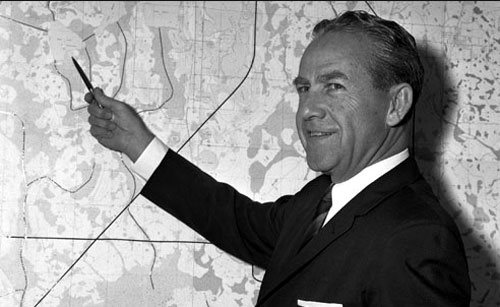
William E. "General
Joe" Potter points to the Magic Kingdom
construction site.
Copyright Disney Enterprises, Inc. All rights reserved
Who's General Joe Potter? Well, prior to his time spent
working with Moses, Potter spent many years working with the Army Corps of
Engineers. Joe was a man who accustomed to taking on big jobs and getting them
done. At one point, Potter had actually been governor of the Panama
Canal Zone.
After watching Potter masterfully ride herds on the
construction of the dozens of different pavilions that were rising up out of
Flushing Meadow, Walt knew that Joe was exactly the guy he needed to help turn
all those cypress swamps in Florida
into a vacation paradise. Which is why — as the Fair was drawing to a close in
late 1965 — Disney offered Potter a position with the Disney organization.
In the end, Potter was the man responsible for turning the
28,000 acres of Florida swampland
that Disney had purchased outside of Orlando
into a workable construction site. Starting in July 1967, Joe and his staff dug
44 miles of canals. Potter's crew also drained the 450-acre Bay Lake,
scraped the bottom clean, refilled the lake, then move 9 million cubic yards of
earth to create a nearby lagoon. This monumental effort led to the creation of
the scenic centerpiece of the Magic Kingdom Resort area: Seven Seas Lagoon.

The Seven Seas Lagoon worksite
as seen from above. Copyright Disney
Enterprises, Inc. All rights reserved
So who knows if Walt Disney World would have become the
enormous success it is today if Gen. Joe Potter hadn't been available to help
carve this vacation paradise out of the Florida
wilderness. Of course, Walt probably wouldn't have even met Joe if the Disney
organization hadn't done all those shows for Robert Moses and his 1964 New
York World's Fair.
So — in the end — I guess maybe the Fair WAS actually the
vital stepping stone in the creation of Walt Disney World. But just not in the
way you might have thought that it was.
Theme Parks & Themed Entertainment
The ExtraTERRORestrial Files

This article is an adaptation of an original Jim Hill Media Four Part Series “The ExtraTERRORestrial Files” (2000).
It was the attraction that was supposed to be the next big thing for the Disney theme parks. The show that would change forever how guests would think about the Mouse by mixing in-theater effects with 3D sound to create high-tech terror.
At least that was what was supposed to happen. But — instead of becoming a franchise attraction like Space Mountain, with different versions of the ride being built in Anaheim, Orlando, Tokyo and Paris — only one version of this Tomorrowland show ever made it off the drawing board.
“Alien Encounter.” Eight years after this hi-tech horror show first opened — then quickly closed for a mysterious six month revamp — this Disney World attraction still remains highly controversial in theme park circles. Many WDW fans consider this intense show to be the best thing WDI’s ever done. Other Disneyana enthusiasts — particularly those with small children — think that this horror show is horrible. They argue that something this scary just doesn’t belong in the Magic Kingdom.
Well, if you thought that “Alien Encounter” — the attraction — was scary … wait ’til you hear the terrifying behind-the-scenes tale of how this troubled Tomorrowland show was creates.
It begins on a dark night … where a dark man waits … with a dark purpose …
No. Wait. My mistake. That’s “Aladdin.”
Michael Eisner’s Plan for Theme Park Attendance
The “Alien Encounter” story actually begins back in September of 1984, when former Paramount studio head Michael Eisner first took control of Walt Disney Productions. Upon entering the Mouse House, one of Eisner’s first goals was to boost sagging attendance levels at the company’s theme parks. While it was obvious that Disney had a lock on the family audience, Michael believed that the Mouse’s parks lacked teen appeal. He based this opinion on his teenage son, Breck, who — when asked by his dad to join him a familiarization tour of Disneyland — reportedly said “That place is lame, Dad.”
Fearing that his son spoke for teens everywhere, Eisner quickly commissioned a marketing survey. Teenagers exiting Disneyland and the Magic Kingdom at Walt Disney World were asked what they thought the Mouse’s theme parks were missing. These teens reportedly said that they wanted more thrill-based attractions in the Disney parks, similar to what they could find at the “Six Flags” parks and Universal Studios.
Something radical to cut through all the sweetness.
With the results of this survey in hand, Eisner ordered WDI to immediately begin development of several radical new shows that could be added to the Disney theme parks. Buoyed by the acclaim “Star Tours” had received when that simulator ride first opened at Disneyland in January 1987, the Imagineers toyed with the idea of bringing a few more of 20th Century Fox’s sci-fi creatures on board at the company’s theme parks.
But these wouldn’t be George Lucas’s cute and cuddly “Star Wars” creations. The Imagineers wanted the black and slimy, acid drooling monsters from the hugely popular “Alien” movie series.
Bringing “Alien” to Disney Parks
Strange but true, folks. Using the story and settings from the first “Alien” film as a starting point, the Imagineers cooked up a concept for a hi-tech interactive attraction they called “Nostromo.” On this proposed attraction, visitors would have rolled through the darkened corridors of the Nostromo — the spaceship Ripley (Sigourney Weaver) piloted in the first “Alien” film — riding inside of heavily armored vehicles. Armed with laser cannons, these folks were supposedly on a rescue mission. Their goal was to find the missing members of Nostromo’s crew as well as rid the spaceship of all alien intruders.
“Nostromo” certainly was a radical new idea for a Disney theme park attraction. Perhaps too radical. In the end, WDI opted not to go forward with the “Alien” ride project. Why for? Well, while they recognized that “Nostromo” would have been a thrilling addition to any theme park, certain senior members of the Imagineering staff voiced concerns that any ride that featured the “Alien” monsters might be too dark and intense for Disney’s family-based audience. These same Imagineers were also troubled by the image of children blasting space monsters with laser cannons. “Walt would never have approved of a ride like this,” they grumbled. So WDI’s first stab at an “Alien” attraction ended up being blown out an airlock. This show concept never made it off the drawing board.
Well, even though “Nostromo” was a no go, some good did eventually come out of the aborted attraction. 13 years after work on the interactive “Alien” ride-thru show had been halted, Tomorrowland finally got its laser-cannon, alien-blasting attraction … but in a much more family friendly form. WDW’s “Buzz Lightyear Space Ranger Spin” uses many of the concepts that the Imagineers created for their first “Alien” show.
Plus all the development work WDI did on the proposed “Nostromo” attraction did make Disney executives aware of the inherent in-park value of the “Alien” monsters. So the Mouse decided to license 20th Century Fox’s characters for use in its theme parks. Ripley and the “Alien” monsters were featured prominently in the “Great Movie Ride” when that attraction opened at the Disney-MGM Studios Theme Park in May 1989. But except for the first few years of the Fox licensing deal that was the extent of Disney’s use of the “Alien” characters in their theme parks.
Updating “Mission to Mars”
A year or so later, some youngish Imagineers were wondering what to do with “Mission to Mars.” Eisner had tasked them to come up with a thrilling new replacement for this lame old Tomorrowland show. He wanted something just as exciting as “Star Tours,” but in a sit-down theater setting.
Just down the hall, another group of new Imagineering employees were looking for ways to use a 3D sound system Disney had just developed. A small post-show attraction at Disney-MGM Studio’s “Monster Sound Show” — where guests were exposed to auditory illusions like too-close haircuts and arrows whizzing by their ears — was the first use, and it hinted at the system’s possibilities. But these Imagineers dreamed of doing something bigger with 3D sound. Maybe building a whole show around the cutting edge system, even.
Inevitably, the “Mission to Mars” team met up with the 3D sound system guys. Then someone remembered that Disney had licensed the monsters from “Alien” for theme park use. Mashing all three of these ideas together, this young enthusiastic group of Imagineers began mapping out plans for an attraction that they hoped would change the way people thought about Disney theme parks forever …
“Alien Encounter” Project
The Imagineers had decided to go for broke.
This being WDI’s first real attempt at a horror-based attraction, the “Alien Encounter” project team didn’t want to just frighten their audience. They wanted to break through the fourth wall and really assault the guest’s senses. That’s why they decided to push the envelope when it came to the proposed show’s use of in-theater effects.
Picture this: The audience sit in the darkened “Mission to Mars” theater. They’ve told that the monster from the “Alien” movies is loose in the building. They can hear the creature creeping up behind them. They can feel its drool dribbling onto their clothes. And as the monster’s tongue begins flicking through the hair on the back on their head … AIEEE!
All these atmospheric elements that WDI wanted to use to make “Alien Encounter” a sensory break-through show may sound cutting edge and expensive. In truth, they were all low-tech effects that were incredibly easy to do. The sensation that the monster is right behind the audience member, breathing down their neck? Simple. That’s just warm, moist air being blown through a hole in the guest’s headrest — synchronized to raspy breathing sounds on the show’s soundtrack. That dribble of monster drool? That’s less that a teaspoon of warm water — dripped from a precisely positioned pipe, hidden high in the ceiling of the theater. The monster’s tongue, flicking through the guest’s hair? That’s a single strand of plastic coated wire, that quickly pokes out of the headrest and lightly brushes the guest’s hair. All ingenious illusions, it’s true. But — more to the point — they were in-theater effects that could be produced on a bargain basement budget.
Keeping the installation costs down of their proposed new Tomorrowland show was one of the “Alien Encounter” team’s main goals. With the hopes of impressing Eisner with their ingenuity, these Imagineers deliberately designed “Alien Encounter” so that it could be staged in the pre-existing “Mission to Mars” theaters with minimal structural changes to the show building. If all went according to plan, Disney could get a brand new cutting edge attraction at cut-rate prices. Best of all, WDI would finally give Eisner what he’d been begging for all these years: a Disney theme park attraction that had some real teen appeal.
On paper, it looked like this idea couldn’t miss. By combining all these in-theater effects and the “Alien” movie series mythology, Imagineering wouldn’t just be creating a thrilling new show for the “Mission to Mars” theater. They would be moving the Disney theme park experience to a whole new level. This time around, guests wouldn’t just passively sit, watching a show. They’d feel like they were right in the middle of the action.
When Eisner heard the pitch for “Alien Encounter,” he loved the idea. He immediately saw the show as a franchise, an attraction that the Disney Company could install at each of its theme parks worldwide. He quickly okayed development of the project, with the hope that “Alien Encounter” would be ready in time to serve as the centerpiece of Disneyland and WDW’s long overdue Tomorrowland overhauls which were tentatively scheduled to get underway in the early 1990s.
The young Imagineers immediately threw themselves into their work. They quickly created a prototype chair for the “Alien Encounter” attraction that featured hidden speakers in its headrest. VIPs touring WDI during this period were often treated to a demonstration of Disney’s 3D sound system. They vividly recall being strapped into the chair — with the “Alien Encounter” test soundtrack playing through the speakers — squirming helplessly as a monster snuck up behind them.
The demo version of “Alien Encounter” proved to be a hit with WDI visitors. Even so, those same senior Imagineers who had earlier shut down the “Nostromo” project began whispering in Eisner’s ear about their concerns for the new “Alien” project. They still worried that a show built around a creature as frightening as 20th Century Fox’s “Alien” monster didn’t belong in a Disney theme park.
Xenomorph
In response, the “Alien Encounter” team insisted that their proposed attraction had to be built around 20th Century Fox’s monster. Their argument was simple: by using a character that most theme park visitors were already familiar with, the Imagineers didn’t have to waste precious showtime on needless exposition. In-park surveys showed that the average Disneyland guest already knew who the “Alien” monster was. Upwards of 80% of those polled had seen one or more of the films in the series.
This — the Imagineers argued — was the added bonus of using the monster from the “Alien” film series for their proposed attraction. Guests who’d seen the “Alien” movies and liked them would rush to see an attraction based on the series. Those Disney theme park visitors who hadn’t cared for the movies would just steer clear of the new show. It was a win-win situation.

Having listened to both arguments, Eisner sided with the “Alien Encounter” team. Recalling the boffo business Disneyland did when “Star Tours” opened, he reasoned that another attraction based on a popular sci-fi film series could have a similar impact on attendance. Besides, having a direct tie-in to 20th Century Fox’s movies would make “Alien Encounter” that much easier to promote. It seemed like the logical choice to Eisner.
This news appalled the senior Imagineering staff. They were horrified at the thought of the “Alien” movie monster starring in a Disney theme park attraction. Since Eisner hadn’t heeded their counsel, these Imagineers decided to appeal to a higher authority: George Lucas.
Working with George Lucas
At the time, Lucas was working closely with Walt Disney Imagineering. He was helping WDI finalize plans for the “Indiana Jones Adventure,” a ground-breaking new attraction that the Imagineers hoped to install at Disneyland’s Adventureland in the mid-1990s. Given Lucas’s extensive experience with special effects and sound effects, he and his staff at ILM were also doing some consulting on the “Alien Encounter” project.
What is known is that these senior Imagineers discreetly approached Lucas and voiced their concerns about “Alien Encounter” being too intense for small children. George allegedly listened politely, then agreed that 20th Century Fox’s movie monster probably didn’t belong in a Disney theme park. Lucas promised to talk to Eisner about the proposed attraction, and then …
New Alien-Monster
A few days later, Eisner called a meeting with the “Alien Encounter” production team. He announced that he’d had a change of heart and no longer believed the show should be built around 20th Century Fox’s movie monster. Eisner went on to say that he felt that the “Alien” monster was just too scary to serve as the central character of a Disney theme park attraction. He then said — while he appreciated all the hard work the Imagineers had put into the Fox monster version of the show — he was certain that WDI could come up with a monster of its own that would be just as good. One not quite as frightening as the first monster was, mind you, but something that would still work within the confines of the show.
Oh … and one other thing Eisner mentioned: George Lucas would now be acting as an unofficial producer on the “Alien Encounter” project.
While the senior Imagineers were secretly thrilled with this news, the “Alien Encounter” team was aghast. Rework the show so that it no longer featured the movie monster? Was that possible? Would “Alien Encounter” still work under these conditions? And why was Lucas suddenly riding herd on the project?
It was at this precise moment that many folks at WDI believe that “Alien Encounter” went off track. By not making use of 20th Century Fox’s well known monster, the show suddenly lost its hook. Without having the easily recognizable “Alien” creature driving the action of the show, the attraction’s storyline became harder for the average theme park guest to follow. The Imagineers would now have to make sure that the audience understood exactly what their new monster was capable of doing before they turned off the lights. Otherwise, the guests would just sit there in the dark, having no idea what was going on around them.
Since the initial concept for the “Alien Encounter” show had now been creatively compromised, many at WDI felt that Imagineering should have pulled the plug on the project. But Eisner was still so enthusiastic about the idea of Disney doing a “monster-in-the-dark” show. He seemed downright eager to give the Imagineers all the money they needed to develop all those special in-theater effects. And WDI did want to keep the boss happy.

So the Imagineers reluctantly began to revamp “Alien Encounter.” But — before they started on a new version for the show — one of the first things they did was called Disney’s publicity department. The Imagineers then asked the PR people to return all “Alien Encounter” pre-production art they had been given to help promote the proposed attraction. The reason the Imagineers did this? All that artwork was from the original version of “Alien Encounter,” which prominently featured 20th Century Fox’s movie monster.
Disney’s PR department ignored WDI’s request. In fact, they continued to use that “Alien Encounter” pre-production artwork — which clearly showed 20th Century Fox’s monster bursting out of the tube at the center of the proposed attraction — to promote the show for the next two years.
Developing the “Alien Encounter” Story
The Imagineers then turned their attention to producing a new script for “Alien Encounter.” For months, they labored — trying to come up a new plot line that audiences could grasp quickly. Finally, they settled on the ‘XS Tech’ scenario — where a sinister alien corporation tries to sell teleportation equipment to the people of Earth … when something goes horribly wrong! Admittedly, this version wasn’t nearly as much fun as the original 20th Century Fox’s “Alien” based story. But the Imagineers hoped that the show’s innovative use of in-theater effects would still put “Alien Encounter” across to the Disney theme park audience.
Eisner — who reportedly really enjoyed the jabs at greedy corporations the Imagineers slipped into this version of the script — okayed the ‘XS Tech’ scenario. Lucas also gave his approval of the new storyline. So WDI threw together a production team and gave the project a preliminary budget. With that, work on ‘Alien Encounter’ officially got underway in the fall of 1992.
The “Alien Encounter” Team
Given the multi-media aspect of the show, lots of individual pieces had to be put together before Imagineering knew if “Alien Encounter” was actually going to work. Academy Award nominee Jeffery Jones, comic Kevin Pollak and TV favorite Kathy Najimy were hired to play XS Tech employees for the film vignettes to be featured in the attraction. Elaborate foley sessions were staged to record the numerous 3D sound effects used in the show. AA figures for the pre-show, as well as the two “Mission to Mars” theaters, were built at WDI’s Tujunga facility.
Imagineering Troubles
As work continued on “Alien Encounter,” Imagineers assigned to the project kept wondering when George Lucas was going to get actively involved with the show. During the development of “Star Tours” and the “Indiana Jones Adventure,” Lucas had played a very active part in the creative process on these attractions. But on “Alien Encounter,” Lucas offered very little input. After attending a few initial story meetings, he pretty much left the Imagineers working on the show alone. For all intents and purposes, George was the absentee landlord of this attraction, its producer in name only.
Now, it’s crucial to understand that — while “Alien Encounter” was actually in production — the Imagineering division of the Walt Disney Company was going through one of the worst periods in its corporate history. Euro Disneyland has just opened and was hemorrhaging money. The Westcot and Port Disney projects had stalled. And Disney management was putting tremendous pressure on the division to cut staff and contain costs.
So WDI was hit by wave after wave of layoffs, which left the remaining staff depressed and demoralized. Then Imagineering management — in a further attempt to keep costs down — decided to cut back on in-house testing on work-in-progress attractions.
This last bit of news terrified the “Alien Encounter” production team. WDI had never put together a theme park attraction that was as complicated as “AE” was. For this show to succeed, video clips, binaural sound, in-theater physical effects, and audio animatronic figures would all have to work in perfect synchronization. Without that split second blending of multimedia technology, “Alien Encounter” would be a hopelessly jumbled mess.
To avoid this sort of disaster, the Imagineers needed as much time as possible to run tests on the “Alien” attraction at WDI headquarters in Glendale, CA. At least there — if they ran into problems — the “Alien Encounter” team would have other talented Imagineers right on hand to help them quickly debug the attraction.
WDI management wouldn’t hear of it. They insisted that — after the physical pieces of “Alien Encounter” were completed — they were to be immediately shipped out to the field for installation. After the equipment was loaded into the “Mission to Mars” show building, then the “Alien Encounter” team could make all necessary adjustments to make the show succeed.
The “Alien Encounter” team begged for more time, but WDI management turned a deaf ear to their pleading. They couldn’t be bothered with the production staff’s complaints that their show wasn’t getting enough advance in-house testing. The heads of Imagineering were far more concerned with determining which Disney theme park would get the “Alien Encounter” attraction first.
Disneyland – “Tomorrowland 2055”
Almost from the inception of the project, it had been assumed that the “Alien Encounter” show would open at Disneyland first as part of the “Tomorrowland 2055” project.
“Tomorrowland 2055.” Sigh. Just mentioning the name of this proposed Disneyland redo is enough to send some Imagineers into a spiraling depression. Championed by veteran Imagineers Bruce Gordon and Tony Baxter, “Tomorrowland 2055” wouldn’t have just been a simple retheming of this side of the park. But rather, a elaborate rethinking of the whole Tomorrowland concept.
“Tomorrowland 2055” Concept
Picture Disneyland in 2055. A time when a trip into the vast reaches of outer space is no big deal, like strolling ’round the block. An age when we take for granted that there’s intelligent life elsewhere in the universal. How do we know for sure? Because quite of a few of these extraterrestrials have made the star trek to Anaheim and have set up shop here right in Tomorrowland.
I mean, take a gander at what used to be the Carousel of Progress. No, that’s not a spinning electronics trade show. That, my friend, is a full-sized flying saucer that’s vaguely reminiscent of the Mother Ship from “Close Encounters of the Third Kind.” Were you to wander up that gangplank, you could sample the out-of-this-world entertainment presented at “Plectu’s Fantastic Intergalactic Review.”
Overhead, shiny steel catwalks allow guests access to a whole new level of Tomorrowland shops and restaurants. On the ground, odd crystalline shapes that glowed brightly and weirdly shaped other-worldly plants would have given this side of the park a truly exotic feel.
“Tomorrowland 2055” would have become a real showplace at Disneyland. It could have set a whole new standard for theming and storytelling at the Anaheim park by taking guests on a fantastic trip to the future. But what do we get instead? An economy class ticket to “Imagination and Beyond” aboard Tomorrowland 1998.
Sigh.
Now do you understand why Imagineers get depressed when you bring up “Tomorrowland 2055?”
Budget Cuts to “Tomorrowland 2055”
Don’t get me wrong, folks. Baxter and his “Imagination and Beyond” team did do the best they could with the money they had. And they did create a dazzling new entrance to Disneyland’s Tomorrowland by bringing Disneyland Paris’s Orbitron over to Anaheim, placing it just off the hub and framing it with that rockwork.
But the loss of “Tomorrowland 2055” still pains the Imagineers. Mostly, because this Disneyland redo seemed like a done deal. So much so that Disneyland actually closed its “Mission to Mars” attraction in November 1992 to make ready for the supposedly soon-to-begin radical revamp of this side of the park.
The Imagineers even designed a new art deco exterior for the show building that was to house the Anaheim version of “Alien Encounter.” (Those of you lucky enough to see “Theme Park Design: The Architecture of Reassurance” exhibit during its nationwide tour a year or so ago may recall the model for Disneyland’s “Alien Encounter” show building. Its chief design feature was the stylized sculptures of oppressed workers that served as support columns for the exterior of the attraction. Insert your own over-worked Disneyland employee joke here.)
Sadly, Disneyland’s long planned “Tomorrowland 2055” project hit an unexpected snag in early 1993 when the Euro Disneyland resort began hemorrhaging money. Suddenly concerned about containing cost in all corners of the Disney Company, Eisner reportedly balked at the estimated cost of the elaborate Anaheim redo. Though Michael really liked a lot of the concepts WDI had cooked up, he just couldn’t stomach “Tomorrowland 2055″‘s projected price tag. At least not then. So he ordered Tony’s team to scale back their plans until they came up with something more affordable for Anaheim. All that redesign work pushed the start of construction on Disneyland’s new Tomorrowland back from Fall 1994 to Spring 1997.
Remnants of “Tomorrowland 2055”
The loss of “Tomorrowland 2055” for Disneyland remains a real sore point with many Imagineers, particularly since Eisner came so close to actually greenlighting the project. How close? The next time you’re at Disneyland, go into the Tomorrowland Terrace and look up at the ceiling. Pretty cool, huh?
This ceiling was actually done as a test for “Tomorrowland 2055,” to see if the wild palette of colors and shapes WDI proposed using on this part of the park would work. A similar test was done on the old “Mission to Mars” show building, where one stylized window was retrofitted onto the exterior of the attraction.
Tests were also made for the atmospherics that would have been featured in “Tomorrowland 2055.” Bruce Gordon commissioned a new soundtrack for the proposed revamp of the park. This futuristic music wittily combined old Tomorrowland favorites like “Miracles and Molecules” and Buddy Baker’s “Monorail March” with memorable Epcot tunes like “It’s Fun to Be Free.” Bruce even got this recording played regularly in Disneyland in the mid-1990s. The downside was that the only place you could really hear the entire “Tomorrowland 2055” soundtrack was if you stood inside the Tomorrowland men’s room for an hour or so. Which made it kind of tough for female Disneyana fans to check out the new tunes. But I digress …
The ceiling, that window, and Bruce’s soundtrack music weren’t the only pieces of “Tomorrowland 2055” that actually made it into Disneyland. Take a look to the Moonliner. A recreation of that 1950s Tomorrowland icon also factored heavily into “2055”‘s design plans. But not as some dinky drink dispenser. Picture that slick looking retro-rocket being three times as high as it is now, towering over Tomorrowland.

The Imagineers were so certain that the Moonliner would make a cool icon for “Tomorrowland 2055” that they actually had a logo made up for this Disneyland redo project that prominently featured the sleek finned spaceship. This image was then slapped on “Tomorrowland 2055” production team jackets, t-shirts, and coffee mugs.
These in-house WDI promotional items for “Tomorrowland 2055” have now become highly prized items among Disneyana collectors. The Imagineers? They really don’t seem to like seeing this stuff. It just brings back too many painful memories of a great thing that almost happened.
Sigh.
“Alien Encounter” at Walt Disney World
Enough about the tomorrow that never came … let’s get back to the saga of “Alien Encounter,” shall we?
The delay of Disneyland’s Tomorrowland redo meant that — by default — “Alien Encounter” would open in Florida first. Disney’s sensory horror attraction would have its world premiere in the Fall of 1994 at WDW’s Magic Kingdom. The show would be the last thing to open as that park completed its own year-long rehab of its Tomorrowland section.
This change of plans also meant that it would be a year or more before serious work would continue on “Alien Encounter.” That’s why the team at WDI that originally dreamed up the project moved on to other assignments. In the interim, Eisner began to have real concerns about whether or not this proposed Tomorrowland show would be too scary for the typical Disney theme park guest to handle. So he ordered WDI to assign a new team of writers to the “Alien Encounter” project deliberately lighten the show up a bit, add a few laughs to the attraction.
This these Imagineers did. Which made Eisner happy. The downside is that these new gags significantly weakened the show’s story. But that wouldn’t become apparent ’til things were almost too far along at WDW’s Magic Kingdom.
Speaking of which … Walt Disney World senior staff was thrilled when they learned that the Florida park would get to premiere this ambitious new attraction. That’s why WDW’s publicity department pulled out all the stops to promote “Alien Encounter.” This office created a clever series of teaser ads that made the soon-to-open show sound like the scariest thing that had ever been staged in a Disney theme park. WDW management was so certain that the attraction would be a hit with the public that they ordered up a ton of “Alien Encounter” souvenir merchandise.
Exterior work on the old “Mission to Mars” show building was completed by August. WDI’s installation team had “Alien Encounter”‘s hardware loaded in by late October. All that was left for Imagineering to do was a few weeks of on-site “test and adjust” work on the attraction. Then they’d turn “Alien Encounter” over to the operations staff at WDW’s Magic Kingdom.
That was the plan, anyway. WDI spend the first part of November training the opening crew for “Alien Encounter.” They’d then run a few test audiences through the attraction … just to make sure that everything worked the way it was supposed to. With any amount of luck, “Alien Encounter” would be up and running by late November and the California-based Imagineering installation team could be back home in time for Thanksgiving.
Too bad it didn’t quite work on that way.
The Team That Built “Alien Encounter”
But — up until that point — everything about this Tomorrowland attraction seemed to be right on track. After all, Disney had its “A Team” working on its “ExtraTERRORestrial Alien Encounter” show.
I mean, listen to the folks that the Mouse had riding herd on the original version of WDW’s “AE” show:
Tom Fitzgerald, Senior Vice President of Theme Park Productions. Tom had had a hand in the creation of numerous Disney theme park attractions that successfully combined film elements with audio animatronic figures. Prior to “Alien Encounter,” Fitzgerald had helped produce “Star Tours,” “Jim Henson’s Muppetvision 3D” as well as “From Time to Time.” So Tom certainly seemed up for the “AE” challenge.
Then there was Eric Jacobson, Senior VP in charge of Creative Development at Walt Disney World. Name a huge new attraction that’s opened at the Florida parks in the past 10 years — “GM Test Track,” “Rock ‘n’ Roller Coaster,” etc. — and Eric’s probably had a hand in it.
Disney also recruited top notch talent to handle the film portion of WDW’s “AE” attraction. Sitting behind the camera was noted animation director Jerry Rees. Best known as the visual effects supervisor on “Tron” as well as being the director of “The Brave Little Toaster,” Rees had also helped produce another fine little film for the Disney theme parks. Do you remember the “Michael and Mickey” movie that used to run at the Disney-MGM Studios? You know, the one where Chernabog cowered before the Disney CEO and said “Sorry, Mr. Eisner. It’ll never happen again.” Jerry did that.
The Mouse then recruited a talented group of actors to appear in Rees’ “Alien Encounter” film sequences. Among these was Academy Award nominee Jeffrey Jones as Chairman Clinch, the head of X-S Tech; TV favorite Kathy Najimy as the cautious Dr. Femus and comic Kevin Pollak as Spinlock, the impatient alien marketing rep. (Special bonus for all you “AE” trivia buffs: That out-of-this-world spokesmodel you see on the video monitors in the lobby? Under all that green make-up, that’s Supermodel Tyra Banks!)
But — even with all these talented, experienced people on board the project, trying to get “AE” to succeed — there was still no getting around the flaws in “Alien Encounter”‘s badly reworked script. According to WDI insiders, the production’s first real mis-steps came when it was time to decide who would do the voice of the sales-droid in “AE”‘s pre-show.
Hoping that he might be able to give WDW guests a few big laughs before they got scared out of their socks by the show in the main theater, the Imagineers hired Saturday Night Live star Phil Hartman to provide vocals for the robot who ineptly demonstrated X-S Tech’s teleportation technology in the pre-show. Being the old show business hand that he was, Hartman turned in a wonderfully smarmy performance, very reminiscent of his failed B movie actor Troy McClure from The Simpsons.
Imagineering had assembled what they thought was a top flight production. They spent months redoing the exterior of WDW’s old “Mission to Mars” show building so that it became the bland but somewhat sinister looking Tomorrowland Interplanetary Convention Center. When test audiences first entered the inner lobby area in December 1994, they were amused by the numerous in-joke meeting announcements they read on the overhead monitors (Eg: “Lunar Disneyland — The Happiest Place Off Earth” and, my personal favorite, “Mission to Mars: Fact or Fiction?”). After that, these same WDW guests wandered into the pre-show, where they’ll chuckled warmly as Hartman’s robot character accidentally fried Skippy. Smiling broadly, these folks then wandered in the main theater …
… and that’s when all the trouble started.
Scary Problems for “Alien Encounter”
Given how light and comical the pre-show elements of “Alien Encounter” had been, test audiences were shocked by how dark and intense the show in the main theater was. As guests left the “AE” show building, they complained long and loudly to cast members doing exit polls about the attraction that they had not been properly warned that this Tomorrowland show was going to be really, REALLY scary. They had assumed that “AE” would like all of the other supposedly scary Disney theme park shows, which are thrilling … but not truly terrifying.
But even with no 20th Century Fox “Alien” creatures in sight, WDW guests still found this new Tomorrowland attraction plenty scary. And — given that members of the test audience had walked right by huge signs that clearly told everyone about “Alien Encounter”‘s intense nature — the Imagineers wondered what else they could do to better prepare audiences for the show they’d see inside.
The obvious place to start was “AE”‘s pre-show. As funny as Phil Hartman’s performance as the sales-droid might have been, it was clear that this piece of the attraction wasn’t doing that good a job of setting the stage for the show that followed. Sensing that “Alien Encounter”‘s introductory scenes needed more menace, the Imagineers shelved Hartman’s recording as they reworked the script for “AE”‘s pre-show — deliberately putting a much darker spin on the proceedings.
The Imagineers then asked “Rocky Horror Picture Show” legend Tim Curry to come and record some new dialogue for the sales-droid. The new script and Curry’s sinister vocals did the trick. Guests still laughed at what they saw in the pre-show, but they were a little creeped out too. As they turned to enter the main theater, these WDW visitors were now filled with a vague unease. Which meant they were in the perfect frame of mind for the carnage that was to follow.
Having fixed the pre-show, WDI now turned its attention to the “Alien Encounter” attraction itself. Test audiences had found the first version of the 3D sound show intense but also hard to follow. By sitting in on dozens of performances of “AE,” the Imagineers determined that the audience was screaming so long and so loudly at parts of the show that they were missing out on several crucial pieces of expository dialogue. Consequently, a lot of the members of the test audiences had trouble following the original version of the attraction’s storyline.
Disney CEO Michael Eisner — who first experienced “AE” in the field in December 1994 the weekend he was down at WDW to attend the grand opening of Pleasure Island’s Planet Hollywood — also agreed that the attraction had some serious story problems. (It’s been rumored that Michael actually took Sylvester Stallone and Arnold Schwarzeneggar along with him the first time he test-drove this Tomorrowland attraction. Which is not as far fetched as it might seem, folks, given that both of these men were also in Orlando the weekend that Eisner was. Since all three were taking part in the WDW PH festivities. But — to date — I’ve never been able to get any official confirmation on this story. Sorry about that. Anyway …) That’s why Eisner agreed to let the Imagineers shut down “The ExtraTERRORestrial Alien Encounter” — so that WDI could have all the time it needed to make the appropriate repairs to the attraction’s plot holes.
Updating “The ExtraTERRORestrial Alien Encounter”
So all those stories that you’ve heard over the past six years about how Michael Eisner ordered “Alien Encounter” closed because he didn’t think the show was scary enough … well, they’re not entirely true, folks. Sure, Michael wanted extra thrill elements to be added to the show. But the real reason that Eisner allowed the Imagineers to temporarily close “AE” was because he wanted the show’s storyline to come across more cleanly, more clearly, more coherently. Michael’s main aim in closing the show wasn’t to add extra scares. But rather because he wanted “Alien Encounter”‘s story to be easier for the average WDW visitor to follow.
Mind you, this simple sounding task took an awful lot of effort. Some of the changes that WDI made to the “Alien Encounter” show were small and subtle — like waiting an additional six seconds before playing a crucial piece of dialogue over the speakers in the theater (just so the line wouldn’t be drowned by the audience’s screams). Other changes involved providing the people who were in the middle of experiencing “Alien Encounter” with additional visual reference material (I.E. throwing a graphic up on the theater’s four video monitors that clearly shows that the monster that was trapped inside the teleportation tube has a pair of wings … that brief image was just enough to get WDW guests to finally understand how the monster was making its way around the room once it supposedly broke out of the containment field).
Perhaps the biggest change that was made to the in-theater portion of the “Alien Encounter” attraction was the show’s new finale. In the original, jokier version of “AE,” after the alien has been successfully beamed out of the theater, Chairman Clinch is finally beamed in. However — given how disastrously the demonstration has gone — Spinlock and Femus are reluctant to raise the blast shield on the teleportation tube. So, as WDW guests exited out of the theater, they could clearly hear the increasingly exasperated X-S Tech Chairman banging on the inside of the tube, demanding to be let out.
Again, a funny idea. But not really in keeping with the tone of the scary show that preceded it. That’s why the Imagineers opted to drop the gag-filled ending of the show and go with a new “Blood & Guts” finale. To add a disgusting coup de gras to the whole “Alien Encounter” experience, the guests seated in the “AE” theater now got splattered with warm water just as the teleportation device supposedly overloaded and blew the evil alien creature in a million tiny wet chunks. (To put a grotesque but funny tag on this part of the show, the Imagineers deliberately added one additional piece of dialogue to “AE”‘s explosive finale. The fat stupid guy who’s supposedly been sitting behind you now says “Yuck! I had my mouth open.” Ewwww!)
Given that most of these changes don’t seem all that involved — a new line here, a graphic there — why did it take the Imagineers so long (nearly six months) to finally fix WDW’s “Alien Encounter?” Simple. Given all the elaborate technology that was necessary to seamlessly co-ordinate the hundreds of elements of this Tomorrowland show, it took weeks to properly reprogram the show’s computers so that they could smoothly handle even the simplest of changes.
For all you techno-nuts out there, here’s a little insight in the gear involved with running “Alien Encounter”: “AE” actually works off of an SSU — a show-supervisor unit. This rack mounted system controls all the lighting and smoke effects as well as the audio and video elements used in the show. This ambitious little machine also keeps tabs on three SIUs — show-interface units. One of these state-of-the art machines rides herd on the pre-show, while the other two take care of the side-by-side sit-down theaters. (Aren’t you glad you asked?)
Shutting Down “Alien Encounter”
In order to get all the necessary changes made (which often involved hours and hours of trial and error), Disney officially closed WDW’s “Alien Encounter” in January 12, 1995 — less than six weeks after the Mouse had been begun doing test and adjust on its new Tomorrowland attraction. Though the show had never officially opened to the public, Walt Disney World was still abuzz with rumors about why the new Magic Kingdom attraction had suddenly shuttered.
The Mouse tried to put a funny spin on the story. They distributed thousands of copies of a flyer property-wide that had supposedly been written by X-S Tech Chairman, L.C. Clinch. In his message to WDW cast members, Clinch apologized for the delays involved with getting “Alien Encounter” opened. “We look forward to a profitable relationship with your species,” or so said the pretend memo. The flyer then went on to say that the projected re-opening date for this new Tomorrowland attraction was Easter 1995.
Unfortunately, the Easter Bunny would be long gone before most WDW guests finally their chance to “Seize the Future with X-S.” It wasn’t until June 20, 1995 before “The ExtraTERRORestrial Alien Encounter” officially re-opened in Disney World’s Magic Kingdom. By then, Michael Eisner had reportedly lost all enthusiasm for this new Tomorrowland attraction.
The End of “Alien Encounter”
What exactly caused Eisner to sour on it? Some say that it was the additional $10 – $15 million Disney had to pump into “Alien Encounter” so that this new Tomorrowland attraction would finally play properly for WDW guests. Others suggest that it was all the negative publicity that was associated with the “AE” redo.
The most likely reason for the Disney CEO falling out of love with “The ExtraTERRORestrial Alien Encounter” attraction? I believe that Eisner eventually began to believe what those old Imagineers had been saying: that a scary show like “AE” doesn’t really belong in the Magic Kingdom. Given the hundreds of letters that the Walt Disney Company still receives every year from angry WDW guests — people who’d just gotten off “Dumbo the Flying Elephant” or just been whirled around in the Teacups, only to unwittingly wander in “Alien Encounter” and find themselves locked down in a chair, suddenly being threatened by a rasping, drooling monstrosity — there are obviously quite a number of folks who feel this way.
Which — to some Disneyana fans’ way of thinking — is a real shame. For — as vocal as “Alien Encounter”‘s critics may be — there’s an equally hardcore group of theme park fans who absolutely adore this Tomorrowland show.
These are the folks that you’ll spy at the N.F.F.C. conventions proudly wearing their “Fried Skippy” t-shirts. These are the same people who eagerly snatched up all the “Alien Encounter” action figures Disney began selling last year. You can usually pick out their cars in the WDW parking lot. Their vehicles are the ones with the Skippy beanie baby sitting on their dashboard.
It probably won’t surprise you to hear that there are also a lot of “Alien Encounter” fans inside WDI. These are the Imagineers who had their hearts set on adding this edgy attraction to every single Disney theme park worldwide. These guys insist that — if Eisner had okayed construction of “Tomorrowland 2055” and followed Imagineering’s original plans for “Alien Encounter” (and not the dumbed down, gag-filled WDW version) — Disneyland’s “AE” show would have been a huge hit right out of the box. A “Star Tours”-sized success which would have served a template for all the other “Alien Encounter” attractions to follow, giving the company a successful franchise show that they could have quickly rolled out at the corporation’s theme parks worldwide.
Ah, but I guess that’s not going to happen now. WDW’s “Alien Encounter” appears to be the one and only version of this high tech new Tomorrowland attraction that will ever make it off the drawing board. (Though I would be remiss if I didn’t mention the “Invasion! An ExtraTERRORestrial Alien Encounter” interactive game that’s currently available for play at DisneyQuest. I’m told that this multi-player game — which is very loosely based on the WDW attraction — is hugely popular at both the Chicago and the Lake Buena Vista DQ locations.)
Editor’s Note: This article is an adaptation of an original Jim Hill Media Four Part Series “The ExtraTERRORestrial Files” (2000). DisneyQuest closed in 2017.
But still you have to wonder. Given that WDI’s reportedly in the process of putting together a new dark, scary, intense attraction — the long-rumored “Armageddon” exploding-Russian-space-station effects show — for both Disney’s California Adventure and Disney Studios Europe, wouldn’t it just be cheaper and smarter just to do “Alien Encounter” as it was originally supposed to be done? Featuring the creatures from 20th Century Fox’s “Alien” movies?
Come on, Disney! “Seize the Future.” Take another stab at doing “Alien Encounter.”
Only this time, don’t let Eisner muck it up.
Want more behind-the-scenes Disney stories? Jim Hill – along with Len Testa and Imagineer Jim Shull did a deep dive on “The ExtraTERRORestial Alien Encounter” attraction on Disney Unpacked. This 51-minute special can be found on Patreon. You can also hear more stories on The Disney Dish podcast, where Jim Hill and Len Testa explore Disney news and park history. Listen now at The Disney Dish on Apple Podcasts.
History
Why Disney’s Animal Kingdom’s Beastly Kingdom Was Never Built
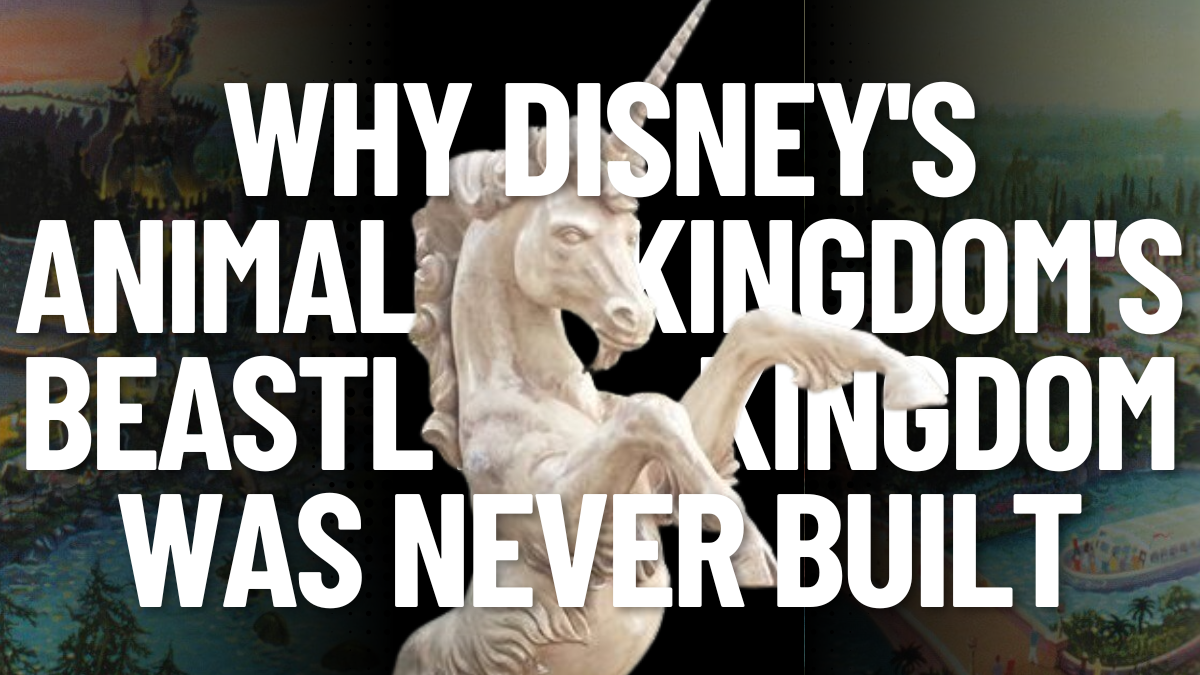
This article is an adaptation of an original Jim Hill Media Three Part Series “Is DAK’s Beastly Kingdom DOA? (December 2000).
You can park your car in the “Unicorn” parking lot.
You can buy your admission ticket at a ticket booth with a huge dragon’s head on it.
And — for a while there — you could even catch a glimpse of a fire-breathing monster as you took a cruise along Discovery River.
So how how come it’s more likely that we will see real unicorns or dragons before the we ever see a “Beastly Kingdom”?
What happened? Why did Walt Disney World decide to scrub its years-in-the-making plans for expansion of its animal theme park? Why table what would seem to be a sure-fire addition to Disney’s Florida resort?
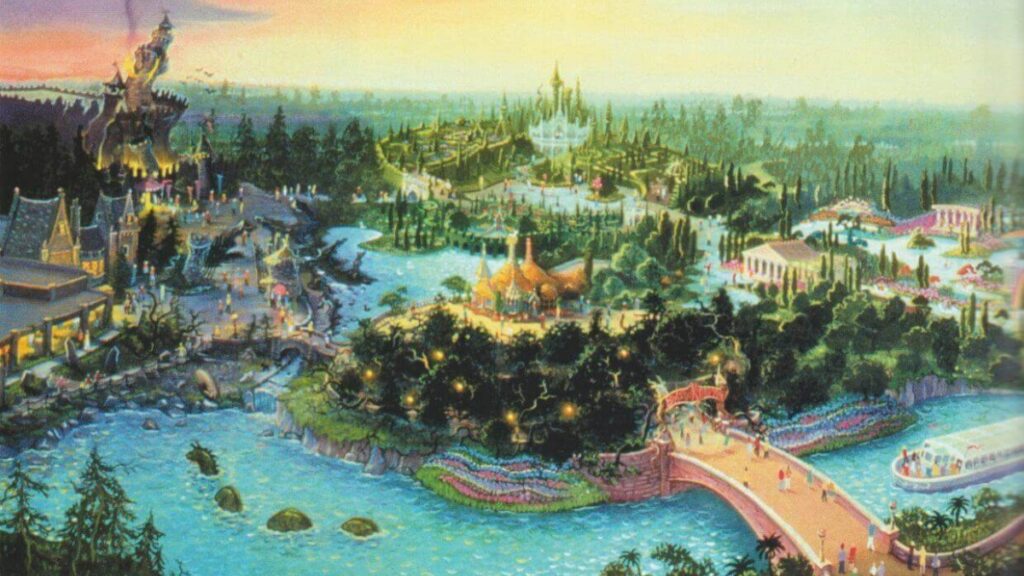
The Price Tag on Building a New Land
Those who have been following the Walt Disney Company’s over the years will not be be surprised to learn that the projected high price tag for building “Beastly Kingdom” factored heavily in upper management’s recent decision to postpone indefinitely any major expansion of Disney’s Animal Kingdom. After all, if times are so tough for the Mouse that they have to lay off the Magic Kingdom’s marching band as well as Epcot’s fife-and-drum corp, what are the chances the company would be willing to spend $200 to $300 million to add a new land to DAK? Slim to none.
Mind you, Mickey was perfectly willing to pony up the $100 million necessary to build the Animal Kingdom Lodge . But that’s different. That’s a hotel. That 1307 room resort starts making money for the Walt Disney Company the moment it opens.
But “Beastly Kingdom?” Exit surveys suggested that — even if Disney went forward with the construction of Beastly Kingdom, Walt Disney World wouldn’t see a large enough increase in attendance at WDW’s fourth theme park to justify the cost of actually building “Beastly Kingdom.”
Guests Wanted to See Unicorns and Dragons at Disney’s Animal Kingdom
The real irony here is that one of the only reasons Disney’s Animal Kingdom ever got built was that way back in 1993, guests who were surveyed about ideas for a fourth WDW theme park responded strongly to the notion of having a place in Florida where they could see unicorns and dragons.
Want to hear what folks were told about “Beastly Kingdom” back then? What follows is an excerpt from an exact transcript of an early marketing presentation on Disney’s Animal Kingdom. It describes in great detail the fun that would have been had in this part of the proposed park:
Beastly Kingdom Marketing Presentation (1993)
Beastly Kingdom is the realm of make believe animals, animals that don’t really exist, out of legends, out of fairy tales, out of storybooks. Like our legends and fair tales about imaginary animals, this land is divided into realms of good and realms of evil.
The evil side is dominated by DRAGON’S TOWER, a burned, wrecked castle inhabited by a greedy, fire breathing dragon. He hordes a fabulous treasure in his tower chamber. The castle is also inhabited by bats who speak to us from their upside down perches. The bats have a plan. They enlist our help trying to rob the dragon and fly us off on a wild chase. At last, we meet the fire-breathing dragon himself and barely escape un-barbecued.
The good side of this land is ruled by QUEST OF THE UNICORN. An adventure which sends us through a maze of medieval mythological creatures to seek the hidden grotto where the unicorn lives. There is also FANTASIA GARDENS. A gentle musical boat ride through the animals from Disney’s animated classic, “Fantasia.” Both the crocodiles and hippos from ” Dance of the Hours” and the Pegasus, fauns and centaurs from Beethoven’s “Pastoral” are found here.
Sounds pretty impressive, yes? Those WDW guests surveyed back in 1993 thought so. They identified “Beastly Kingdom” — with its mix of roller coasters and imaginary animals — as the number one reason that they’d want to visit this proposed fourth theme park.
Opening Disney’s Animal Kingdom is Real Animals
So why wasn’t “Beastly Kingdom” part of Disney’s Animal Kingdom when the park opened on April 22, 1998?
Again, cost played a big part in delaying construction of this highly anticipated land.
But DAK’s future planning had to be factored in too.
After all, it took the Walt Disney Company three years and $800 million just to get “Phase One” of DAK open. And — since the park’s name actually had the word “animal” in it — the Imagineers felt that opening day guests would want to see some actual live animals. So the majority of DAK’s capitalization was poured into building the Africa and Asian safari areas.
After that … well, someone had to make a decision. Disney’s Animal Kingdom was supposed to celebrate all animals: the live ones, the extinct ones, as well as the imaginary. The African and Asian enclosures would take care of the live animals.
But — in doing that — Disney blew through most of DAK’s initial budget. There was only enough money left to build one more land.
Which should the Mouse go for? Dragons or dinosaurs?
“Dinosaur”, Frustrated Imagineers, and Roller Coasters
In the end, the deciding factor here was the money the Disney Company had already blown on the soon-to-be-released computer animated film, “Dinosaur.” Even back in 1995, the Mouse had already invested upwards of $30 million into production of this movie. (Current estimates suggest that Disney may have spent as much as $150 million to finish this film, making “Dinosaur” even more expensive than James Cameron’s infamously over-budget 1997 epic, “Titanic.” ) Eisner wanted to make sure that Disney’s “Dinosaur” movie made a return on that investment, so he insisted that DAK feature an attraction that heavily hyped the forthcoming film.
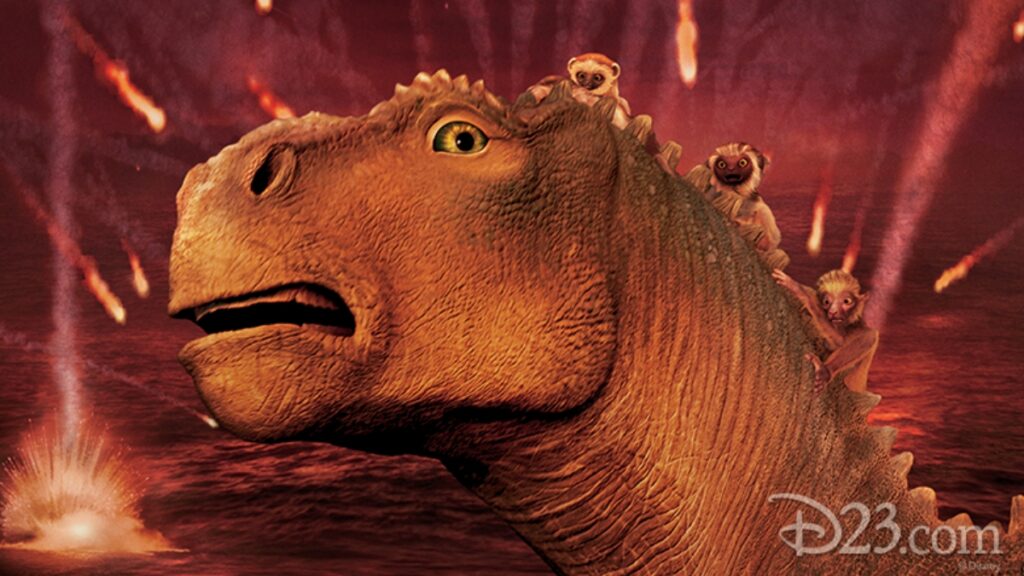
That decision angered Joe Rohde and the other Imagineers on the Disney’s Animal Kingdom project. After all, one of the real reasons that DAK was being built was to keep WDW guests from leaving property to go visit Busch Gardens – Tampa Bay.
And what was Anheuser Busch’s Florida theme park best known for? Its animal displays and its killer roller coasters. With African and Asia, Disney had all the animals it needed. But where were the coasters?
“Dragon’s Tower” at Beastly Kingdom
According to Disney’s Animal Kingdom’s original plans, “Dragon’s Tower” was to have been this park’s signature attraction. That’s why the dragon was featured dead center in DAK’s logo. After guests visited WDW’s fourth theme park, this was going to be the ride they raved about the folks back home about.
What was so special about “Dragon’s Tower?” This high tech thrill ride would have been the Walt Disney Company’s first in-park use of an inverted roller coaster. This attraction would have also featured the largest AA figure ever built for a Disney theme park. The angry jewel encrusted dragon found in the ride’s finale — belching fire and smoke at your car as you zoomed on by — would have easily dwarfed any of the dinos found in “Countdown to Extinction” (AKA the “Dinosaur” ride).
But Eisner insisted that it was more important that DAK feature an area that synergized with the upcoming “Dinosaur” film.
“Beastly Kingdom” would have to wait ’til DAK’s “Phase Two” … which, back then, was to have been completed no later than Spring 2003.
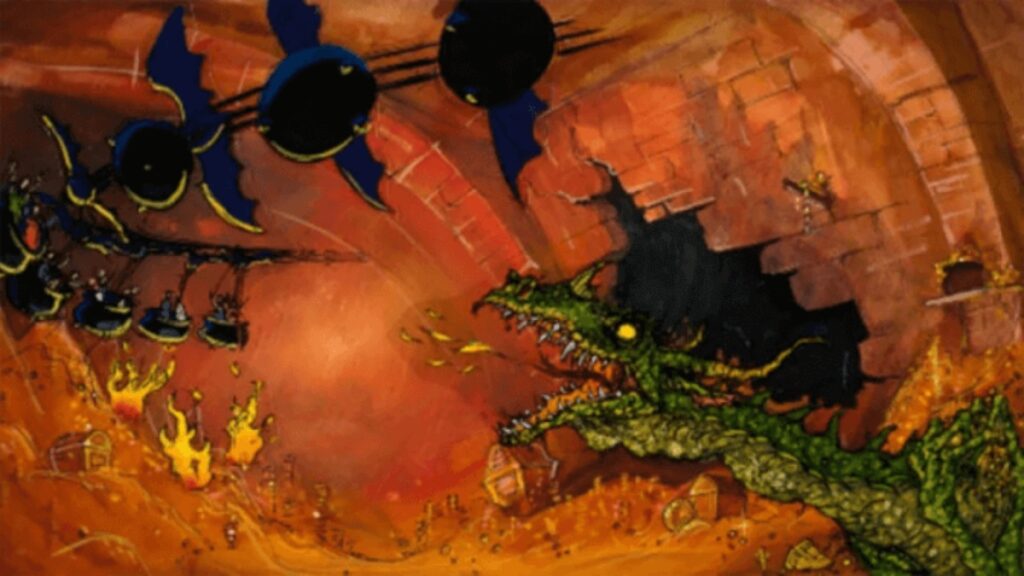
Phase One – “Beastly Kingdom” Easter Eggs
So — with this understanding that “Beastly Kingdom” hadn’t been cancelled, but merely postponed — WDI agreed to scale back their initial plans for Disney’s Animal Kingdom. But, even as they mapped out plans for the “Phase One” version of DAK, the Imagineers deliberately put in some pretty broad hints of the fun yet to come when “Beastly Kingdom” finally opened. That’s why you can park your car in the “Unicorn” lot as well as buy your tickets at the dragon headed ticket booth.
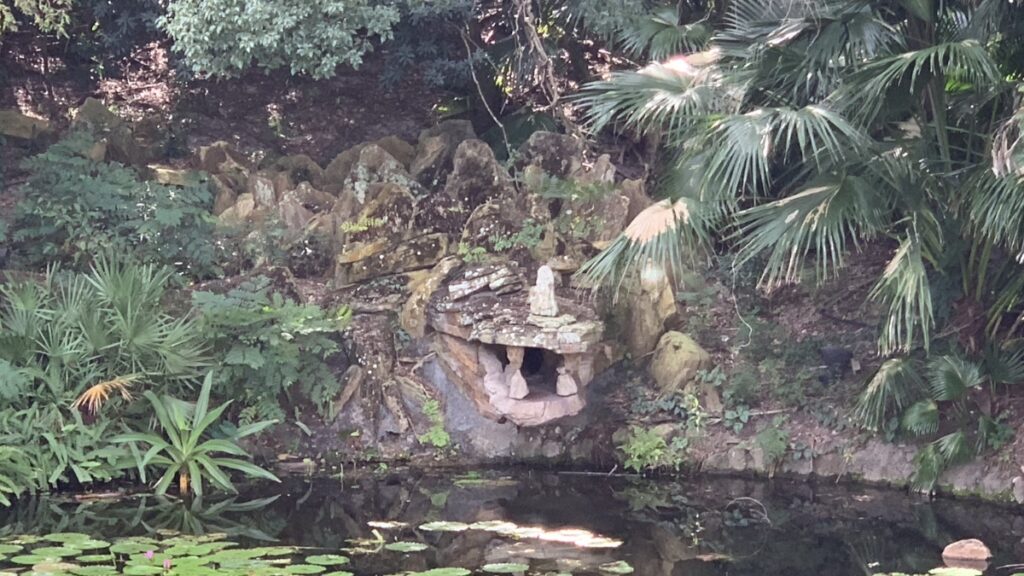
Dragon on Discovery River
As for that fire-breathing dragon found in the cave down along Discovery River … before cost over-runs in other areas of DAK severely cut in the proposed budget for this part of the park, that make-believe monster was just one of many fantastical show elements that would have been found along this part of the river. That whole stretch of Discovery River was supposed to be one big coming attraction for “Beastly Kingdom.”
Had the Imagineers gotten all the money they were originally supposed to get, here’s what you would have experienced after your boat pulled away from the dock and began its cruise around Discovery River:
As you passed under the main bridge leading into Safari Village, you would have seen that the water ahead was littered with the shattered lances and crumpled armor of a great many fallen knights. But what horrible fate could have befallen all of these brave adventurers? A roar from the nearby cave offers a clue.
As your boat floated past the opening of the cave, you would have seen a duplicate of the dragon found in the cavern under Le Chateau de la Belle au Bois Dormant at Disneyland – Paris. Only WDW’s version would have been a lot more active than France’s sleepy monster. This dragon would have craned his neck out of the cave, roared at the guests and then breathed fire their way, before once again settling back down to sleep.
At this point, your boat driver would have started to get nervous. He would explain that he was worried that the dragon’s roaring would awaken the Kracken, a mythical Greek sea monster that was known to lurk along this stretch of Discovery River. Sure enough, the water around the boat begins to bubble ominously.
Off to one side, the huge fin of the Kracken suddenly cuts through the water. As the boat begins rocking back and forth, you’re certain you’re headed for a watery grave. Just then, your captain pulls out a lyre and begins plucking an odd tune. As the boat stops rocking and the water stops bubbling, the captain explains that music puts the Kracken back to sleep. Once that it’s safe to move on, the boat continues to head up river.
Just as you round the bend, your captain points off excitedly to your left. There on the shore, you catch a glimpse of a unicorn. The beautiful white creature — shrouded in mist as it stands in a picturesque grove of trees — paws the earth lightly with one hoof and nods its golden horn our way. The unicorn’s only visible for just an instant, but it truly is a beautiful sight.
As your boat pulls up to the dock in Harambe, you and your fellow guests would still be buzzing about the wonders you would have glimpsed on this leg of your adventure of Disney’s Animal Kingdom …
But of course … this didn’t happen. As DAK’s opening day grew nearer and it became obvious that the whole project was going over budget, great show elements like the Kracken and the Unicorn got cut from the “Phase One” version of the park. In the end, there was only enough money left in the budget for put one creature along the entire length of Discovery River.
Again — because Eisner insisted that “Dinosaur” be heavily synergized at DAK — the Imagineers decided to build a full-scale version of Aladar, the heroic iguanadon from the forthcoming film. That’s the AA dinosaur guests glimpsed roaring and splashing at water’s edge as their Discovery River boat floated past Dinoland USA.
Unfortunately, this decision left the other leg of the Discovery River boat cruise a five minute cruise past nothing. So Joe Rohde begged, pleaded and wheedled … and eventually got Eisner to kick in another couple of thousand dollars. With this tiny chunk of change, Joe was able to get the rock dragon that spews water along this part of the river built, as well as a very stripped down version of the park’s fire breathing dragon.
But don’t go looking for an Americanized version of Disneyland – Paris’s majestic AA dragon to be found along this part of Discovery River. Rohde’s Imagineers did the best they could with zero cash. All you’ll find here now is a somewhat dinky cave at water’s edge. As the boats went by, a ferocious roar would echo out of the cave, followed by a burst of flaming propane. These effects hinted that there was a dragon somewhere deep back inside that cave … but guests never really got a glimpse of the thing.
Discovery River Disappointments
As you might imagine, WDW visitors were pretty unimpressed with what they saw along Discovery River once DAK opened. In fact, this was the ride that guests singled out — right from Opening Day — as the worst attraction in all of Disney’s Animal Kingdom. After waiting in line for over an hour to board the boats, they were furious to find that there was virtually nothing to see along the water during their five minute journey to Harambe.
The Imagineers were obviously embarrassed by this situation. It was particularly frustrating to WDI because they knew that they had a solution to the Discovery River problem, ready to go. But Disney management was too cheap to put up the money to make the fixes.
But that had been typical of Disney management’s handling of the whole DAK project. Given the choice between doing things the right way and the inexpensive way, the Mouse always opted to go cheap.
Disney’s Animal Kingdom Opening Day Capacity Problems – “Camp Minnie-Mickey”
Take — for instance — how the Mouse handled the park’s capacity problems. When it became obvious that Asia was not going to ready in time for Disney’s Animal Kingdom’s April 1998 opening, the Imagineers began warning Disney management that DAK would not have a full day’s worth of shows and attractions. After having paid full price for admission, guests were sure to complain if they only got a half day’s worth of entertainment.
Eisner’s solution? Slap in a temporary land, similar to the “Mickey’s Birthdayland” area that the company had created for WDW’s Magic Kingdom way back in April 1988. From its first conceptual drawing right through to the first guest walking into Mickey’s house, “Mickey’s Birthdayland” had only taken 90 days to install.
Rohde and his Imagineers was appalled at Eisner’s suggestion. But — rather than tell the boss that his idea was terrible and that they wanted nothing to do with it — the DAK design team insisted that they were far too busy supervising construction in the rest of the park to work up any new temporary lands.
So Eisner ordered WDW’s entertainment office to take over the project. Using “Mickey’s Birthdayland” as their template, the entertainment staff came up with the concept for “Camp Minnie-Mickey.” Since there was no money available for even the cheapest of off-the-shelf rides, the WDW team opted to build “Camp Minnie-Mickey” around two low budget stage shows and several no budget character encounter areas.
How quickly and cheaply was “Camp Minnie-Mickey” thrown together? Do the float units the characters perform on in “Festival of the Lion King ” look familiar? They should. They’re the exact same parade floats that Disneyland ran up and down Main Street USA during the three year run of its “Lion King Celebration” parade.
Hope for Joe Rohde and Imagineers in Phase Two
Having this rapidly slapped together area sitting alongside lands that they’d spent years designing really irked the Imagineers. But Rohde advised his team to be patient and hold their tongues. After all, once Disney’s Animal Kingdom opened on April 22, 1998 and proved to be a huge success, then WDI would finally get the time and the money necessary to fix all the stuff that was wrong with the park.
Then the Imagineers could get the chance to put back all the stuff that was cut out of Discovery River. Then they could quietly pull the plug on that monstrosity, “Camp Minnie-Mickey.” Then WDI could finally get around to DAK’s “Phase Two” and build Beastly Kingdom.
Well, April 22, 1998 arrived and Disney’s Animal Kingdom opened …
But — after that — things didn’t quite go according to plan.
Eisner’s Expectations for Disney’s Animal Kingdom
Okay, kids — before we get back to the story of how “Beastly Kingdom” ended up on Disney Animal Kingdom’s (DAK) endangered species list — you need to understand what the Mouse’s original expectations were for its fourth Walt Disney World (WDW) theme park.
Here’s what Disney CEO Michael Eisner had hoped would happen when DAK opened on April 1998:
- Attendance levels would go through the roof at the Magic Kingdom, Epcot, and the Disney-MGM Studios, as a record number of visitors rushed down to Florida to check out WDW’s fourth theme park.
- Guests who had previously stayed on property at Walt Disney World hotels for four days would now book five day vacation packages — just to be sure that they didn’t miss any of the new shows and attractions that had recently been added to the resort.
- All this extra guest traffic would result in increased revenues for WDW’s hotels, shops and restaurants — which would have an immediate positive impact on the Walt Disney Company’s bottom line.
- Eisner and his staff would bask in the glow of the unparalleled success of Disney’s Animal Kingdom for a moment … then get right back to work, brain-storming ideas for WDW’s fifth theme park.
That’s what Uncle Michael had hoped would happen, anyway.
Reality proved to be infinitely harsher.
Walt Disney World Attendance in 1998
In spite of the Mouse’s rosy projections, Disney’s Animal Kingdom — in its first year of operation:
Actually drove down attendance levels at the other three WDW theme parks in 1998.
- 8% fewer guests visited the Magic Kingdom
- 9% fewer went to the Disney-MGM Studios
- Epcot’s attendance levels dipped a startling 11%
What happened? In a word — cannibalism.
How Does Opening a New Theme Park Affect the Other Theme Parks?
“Cannibalism” is the term Disney Company executives use to describe what happens when a brand new theme park opens and begins eating into the attendance levels of the older, more established parks at the same resort.
Epcot Opening
In 1982, when Epcot opened, that park initially cut significantly into the number of guests that annually visited the Magic Kingdom. However — over time — attendance levels at Magic Kingdom bounced back to what they once were after the newness of Epcot had worn off. Meanwhile, Epcot Center began drawing guests all on its own to WDW. In the end, it all worked out just fine.
Disney-MGM Studio Opening
A similar thing happened in May 1989, when the Disney-MGM Studio theme park threw open its gates. For almost a year, attendance levels at the Magic Kingdom and Epcot slumped while guests opted to go to the new WDW theme park rather than visiting their old favorites. But — once again, over time — the situation sorted itself out. Attendance levels at the older WDW parks slowly rose back up to where they once were, as the Disney-MGM Studios began luring millions of new tourists to come see Disney’s Florida resort.
Disney’s Animal Kingdom Opening
The Mouse had been anticipating that — when Disney’s Animal Kingdom opened — that it too would initially bleed guests away from the Magic Kingdom, Epcot, and the Disney-MGM Studios. That’s why Eisner had had the Imagineers add new attractions and/or complete major rehabs to each of the older WDW parks in the 18 months prior to DAK’s opening.
This was Uncle Michael’s brilliant scheme. He honestly believed that — if the Magic Kingdom, Epcot, and the Disney-MGM Studios each had new rides and shows for visitors to see — guests who had come down to WDW just to see Disney’s Animal Kingdom during its first year of operation would still end up of staying on property an extra day or so just to check out all the new stuff at the other parks.
On paper, that really did seem like a brilliant plan. Too bad reality got in the way.
Eisner’s Attendance Plan Doesn’t Go as Planned
What happened to ruin Eisner’s plan? For starters, Epcot’s heavily hyped new thrill ride — GM Test Track — was beset with horrible technical problems and ended up opening a full 18 months behind schedule. So that park really had nothing new to offer to returning WDW guests the year DAK opened.
Over at the Disney-MGM Studios, a much anticipated addition to the park — “David Copperfield’s Magic Underground” restaurant — never made it off the drawing board because the magician’s outside financing for the project disappeared. It would now be months after DAK’s opening before the studio theme park’s next big attraction — an East Coast version of Disneyland’s “Fantasmic” — would be ready to start entertaining WDW visitors.
As for the Magic Kingdom … truth be told, very little thought was put into to adding new shows and attractions to WDW’s first theme park. The Magic Kingdom had always been the favorite with Disney World visitors. Eisner and WDI felt that — what with the recent “Mickey’s Toontown Faire” redo as well as the 25th anniversary parade that was still running daily at the park — there was still plenty of semi-new stuff to entice people into making a return trip to the Magic Kingdom.
So — given all the money the Walt Disney Company had pumped into the Magic Kingdom, Epcot, and the Disney-MGM Studios to counter-act the effects of DAK’s opening — Eisner had anticipated that the attendance levels at WDW’s older parks would only dip by 5% in 1998. He was said to be furious when — almost across the board — attendance fell by almost twice that amount at all three of the other WDW theme parks.
This news immediately put WDW’s management team into crisis mode. The big boys in Burbank wanted attendance levels at each of the older WDW parks driven back up immediately. The managers of the Magic Kingdom, Epcot, and the Disney-MGM Studios reminded Eisner and Company that — in order to do that — they’d need money fast for new shows, parades and attractions. Eisner immediately agreed to free up some funds for the Florida park.
And where did Eisner get the money to create these new WDW shows? You guessed it. He snagged the funds that had been previously earmarked for expansion of Disney’s Animal Kingdom. Specifically, the money that would have been set aside for construction of “Beastly Kingdom.”
“Beastly Kingdom” Defunded – Problems at Animal Kingdom
Rohde and his Imagineers began complaining about the short-sightedness of Disney management’s fiscal planning. With that money gone, it would now be five years or more before there’d be any money in the budget to create any new significant attractions for DAK.
WDW managers admitted that this was true. But — given all the problems that Disney’s Animal Kingdom was having during its initial year of operation — it didn’t seem too wise right now to complain about the park’s future. Unless these problems got resolved quickly, it didn’t look like DAK would have much of a future.
What sort of problems was Disney’s Animal Kingdom having back then? You name it, the park was having problems with it.
Guests Getting Lost at Disney’s Animal Kingdom
Due to the twisty, turny nature of the park’s walkways as well as all the lush vegetation, guests were constantly getting lost as they walked through the park. Disney had to spend thousands on new, bigger signage for the theme park to help guests find their way around the place.
Guests Leaving Disney’s Animal Kingdom Early – Busy in the AM
Then there was all the troubles with DAK’s shops and restaurants. Particularly during the first eight months Disney’s Animal Kingdom was open (when only the African safari adventure was up and running), the Mouse had an awful time getting guests to stay inside the theme park past 4 p.m.
What was the problem? Due to the horrible heat in Florida, most of the animals along the African safari route would go lie down in the shade — disappearing entirely from view — by about 10 a.m. each morning. Once DAK management learned that its African menagerie had begun dropping from sight most days before noon, it quickly put the word out to WDW’s hotels to encourage their guests to visit DAK as early in the day as possible.
This resulted in a completely unworkable traffic flow situation at DAK. By 7:30 a.m. most mornings during that first summer of operation, the park would already be full. By 8 a.m., there’d be a two hour long line in the queue for the African safari ride as well as guests waiting for over an hour to get in to see “It’s Tough to Be a Bug.” Given that so few of Disney Animal Kingdom’s restaurants had been designed to serve breakfast, there were never enough places open at that hour to handle all those sleepy, cranky people looking for food. That first summer at DAK was a complete disaster.
But — as bad as the early morning hours at DAK were — the late afternoon was even worse. Why for? Because the crowds — having blown through Disney’s Animal Kingdom minimal number of shows and attractions in just a few hours — had already left the park for the day. By 4 p.m. most afternoons, you could have fired a cannon down the middle of the street in Safari Village and not have wounded a single soul.
Poor Merchandise and Restaurant Sales
Having the park virtually empty by late afternoon played hell with DAK’s projections for food and merchandise sales. All the managers of the park’s stores and restaurants were begging WDW management for help in turning around their depressed sales. (The folks running the giant “Rainforest Cafe” at the entrance of Disney’s Animal Kingdom were particularly desperate. They had paid big bucks for the right to build this branch of their restaurant chain right outside the entrance to WDW’s newest theme park. But most evenings, barely a third of the cavernous cafe had any guests in it.)
Fixing Disney’s Animal Kingdom with Night-Time Entertainment
WDW management tried to come up with a solution to DAK’s traffic flow problems. But it quickly became obvious that there’d be no quick fixes for this situation. After all, it wasn’t like Disney could do here what they did at Epcot and the Disney-MGM Studios to keep guests in the park at night. Since the lights in the skies and all the noise was sure to frighten the animals, a nightly fireworks display was out of the question.
There was also some talk of creating a special night-time parade to roll through the streets of Disney’s Animal Kingdom and entertain guests after dark. For a time, WDW management even considered bringing Disneyland’s much maligned “Light Magic” streetacular to Florida to provide after-hours entertainment at DAK.
But Rohde and his team of WDI designers quickly killed any talk about night-time streetaculars at Disney’s Animal Kingdom. They pointed out that the park’s streets and trails were just too tight and narrow to allow even the smallest floats easy passage. The Imagineers reminded WDW management how much trouble DAK’s small day-time parade — “The March of the Art-imals” — was having making its way around the park in broad daylight. Imagine how much trouble a similar parade would have making its way around DAK in the dark.
Fix Disney’s Animal Kingdom’s Problem with Attractions – Build “Beastly Kingdom”
Rohde’s team insisted that the solution to the traffic flow problems at Disney’s Animal Kingdom was obvious: beef up the parts of the park that didn’t rely on real animals. That meant adding new shows to Dinoland USA as well as finally building Beastly Kingdom. By adding these additional shows and attractions, WDW management would give guests a real reason to stay at DAK after dark — rather than trying to trick visitors into staying with a lame after-hours parade and/or a smallish fireworks display.
Privately, officials in WDW management agreed with the Imagineers that this was the logical, reasonable way to fix Disney’s Animal Kingdom. The trouble was that the folks back in Burbank weren’t acting reasonably or logically right now. Disney Company management had panicked when they had seen the drastic dip in attendance at WDW’s three other theme parks. Now they were running scared.
And Eisner had already okayed WDW management’s decision to grab the money that had been earmarked for DAK expansion and use it for bolstering sagging attendance at the other three WDW theme parks. That meant that Imagineering had next to no money left to fix all the glaring problems at Disney’s Animal Kingdom. More ominously, it now looked like it would be five years — or more — before WDI could afford to add any significant new attractions to DAK.
It was a very depressing time for the Disney’s Animal Kingdom design team. But — again — Rohde told his Imagineers not to lose heart. He told them that DAK — in particular “Beastly Kingdom” — might still be saved yet.
Competition for Disney – Universal Studios’ Islands of Adventure
For Joe knew that Seagrams / MCA was spending two billion dollars to expand its Universal Studios Florida theme park complex — which was just down the road from WDW. And the centerpiece to this ambitious expansion project was a brand new theme park: Universal Studios’ Islands of Adventure.
Rumors were flying around the theme park community that Seagrams / MCA was spending hundreds of millions of dollars on their new Florida park because they were out to top Disney. Universal wanted “Islands of Adventure” to have such amazing state-of-the-art attractions that this park would top any ride that could be found at Walt Disney World.
Secretly, Rohde and his Imagineers were hoping that Universal Studios’ Islands of Adventure would be a huge success. Why for? Because the Walt Disney Company would then be embarrassed that it didn’t have the best rides in Florida anymore. And then maybe the Mouse would get worried that they were starting to lose guests to the new Universal park.
If that happened … well, then Eisner would finally have to open up his wallet then, wouldn’t he? Just as a matter of pride, he’d have to insist that WDI install the greatest rides that they could come up with at each of the WDW parks. For Disney’s Animal Kingdom, that could only mean that the Imagineers would finally get the chance to build “Beastly Kingdom.”
That was how Joe Rohde hoped things would play out, anyway.
Buzz Around Islands of Adventure Opening
Well, in the spring of 1999, Universal Studios’ Islands of Adventure did finally open up. Unfortunately, it was not quite the roaring success Joe had hoped for.
Worse still, some of the attractions to be found in the new park looked awfully familiar …
December 1998. Everyone at Walt Disney Imagineering (WDI) is abuzz with news about Universal Studios expansion plans for its Florida property.
“I’ve heard that — on opening day — they’re going to have three mega-coasters up and running.”
“Well, I’ve heard that their ‘Spiderman’ attraction is going to blow the doors off ‘Star Tours’ and ‘Body Wars.'”
“That — plus ‘Jurassic Park – The Ride,’ that ‘Dudley Do-Right’ flume thing as well as the ‘Popeye’ raft ride. This new Universal park sound better than anything we’ve got in Florida.”
Were these Imagineers frightened at the thought of all these great attractions being built in a theme park just down the street from WDW?
Hell no. The folks at WDI were thrilled that Seagrams was spending a reported $2 billion to remake their Universal Studios Florida theme park into a Disney quality resort. Why? Because that meant that the Mouse would finally have some serious competition in Orlando.
You see, Disney CEO Michael Eisner is a very competitive guy. He hates to lose — at anything.
If attendance at WDW started to noticeably slip due to the Mouse losing customers to Universal’s new theme park, Michael would have to do something. Eisner’s enormous ego just wouldn’t be able to handle the idea of Disney being No. 2 in the Orlando market.
So he’d turn to the Imagineers and say: “Make the best attractions you can.”
Not “Make the best attraction you can on a limited budget.” (i.e.: WDI’s controversial rehab of Epcot’s “Journey into Imagination” ride. During its three months of operation, the revamped version of that Future World attraction racked up more guest complaints than most shows produce in a year.)
Not “Make the best attraction you can with minimal changes to the pre-existing ride building.” (i.e.: The Magic Kingdom’s “Buzz Lightyear’s Space Ranger Spin” actually runs its ride vehicles along the very same track and layout the building’s previous tenants — Delta’s “Dreamflight” and the unsponsored “Take Flight” — used.)
Not “Make the best attraction that reflects the sponsor’s agenda” (i.e.: Any exhibit you’ll find inside either version of “Innoventions.”)
Just “Make the best attractions you can.” Period.
And WDI would absolutely love to hear Michael Eisner say this.
The Imagineers Finally Able to Build Attractions
For years now, the Disney Imagineers been developing ideas for absolutely killer theme park attractions, only to be told by Disney Company senior management that ” Gee, we’d love to build that … but it’d be too expensive” or “No one else in the industry is doing that” or — worst of all — “We don’t have to try that hard.”
So now — for the first time ever — it appeared that Walt Disney World was going to have some real competition in Florida. And the top guys at the Mouse Works must have been taking Universal’s Islands of Adventure seriously, for — in January 1999 — they ordered WDI to work up a WDW contingency plan.
The purpose of the plan was this: Should Universal’s Islands of Adventure actually begin to seriously nibble away at Disney World attendance levels in 1999, the Mouse wanted a way to quickly recapture those wandering visitors. WDI felt that the easiest way to get folks excited about going back to WDW again was to add a huge new E ticket attraction for each of the four Florida parks. More importantly, they wanted to have each of these rides up and running in time for the kick-off of Walt Disney World’s 30th anniversary celebration in October 2001.
“Fire Mountain” at Magic Kingdom
The Magic Kingdom was to have gotten “Fire Mountain,” a state-of-the-art roller coaster themed around story elements from Walt Disney Pictures’ Summer 2001 animated release, “Atlantis.” What would have truly been intriguing about “Fire Mountain” is that it was to have been the world’s first morphing coaster. Visitors would start their ride seated securely in their ride vehicle. At the midway point in the attraction — as “Fire Mountain” erupted — the bottom would have dropped away from their ride vehicle, leaving the riders dangling from above as they zoomed through the rest of the ride.
“Villain Ride” at Disney-MGM Studios
Over at the Disney-MGM Studios, that park’s signature attraction — “The Great Movie Ride” — would have gotten a massive makeover. In its place, visitors would have been asked to put on 3D glasses before taking a trip through the Chinese Theater’s “Villain Ride.” Here, WDW visitors would have been menaced by three dimensional recreations of Disney’s most famous fiends before the forces of good finally came to their rescue.
“Mission: Space” at Epcot
Epcot would have had its dated Future World “Horizons” pavilion pulled down to make way for the new “Mission: Space” attraction. This cutting-edge ride would use centrifugal force to give visitors the sensation of being blasted out into space. They would also feel tremendous G-forces pressing them down into their seats as well as a brief moment of weightlessness before their ride vehicle made re-entry.
“Beastly Kingdom” at DAK
As for Disney’s Animal Kingdom … well, since it was the least developed of all four of the WDW theme parks, adding just one new attraction wouldn’t have given visitors enough incentive to return to DAK. So the Imagineers opted to go for broke here. They suggested adding a whole new land to Disney’s Animal Kingdom.
Which land? You guessed it, kids. “Beastly Kingdom.”
Disney’s Plan to Counter-Act Universal’s Island of Adventure
Disney Management reviewed WDI’s plan in March of 1999 and agreed to put it into action if … and this is a really big “if” here, folks … it could be proven that Universal Studios’ Islands of Adventure was having a significant detrimental effect of WDW’s attendance levels.
So — for the first time in the history of the Walt Disney Company — the Imagineers actually hoped and prayed for a competitor’s theme park to succeed. For — if Islands of Adventure really had an impact on WDW’s attendance — all of their great new proposed attractions would actually make it off the drawing board.
After two months of soft openings, Universal finally did officially open Islands of Adventure (IOA) on May 28, 1999. Just as the Imagineers had hoped, IOA had it all. Three huge roller coasters. Their state-of-the-art “Spiderman” attraction. Three water-based rides (“Jurassic Park – The Ride,” “Dudley Do-Right’s Ripsaw Falls,” and “Popeye’s Bilge Rat Barges”). Everything a modern theme park needs to succeed.
Well … almost everything.
What was missing?
Crowds.
Was Universal Studios’ Islands of Adventure a Flop?
To this day, no one knows quite what went wrong with the launch of Universal Studios’ Islands of Adventure. Some blame the marketing of the new park and resort, which somehow lead the public to believe that IOA wasn’t a whole new theme park, but rather just a new land that had been added to Universal Studios Florida (USF). (This certainly was a popular explanation within the boardroom at Seagrams. They asked for — and received — the resignations of most of USF’s marketing staff.)
Whatever the reason, the crowds just did not come out for IOA during its first year of operation. Universal’s new theme park under-performed in a spectacular manner, drawing less than half the projected number of bodies Seagrams had said would visit its revamped resort in 1999. Worse still, the limited number of visitors IOA got seems to have all been bodies that the new park lured away from its older Florida theme park. Unconfirmed reports suggest that attendance at Universal Studios Florida may have fallen off by as much as 30% during IOA’s first few months of operation.
But worst of all — at least from the Imagineers’ point of view — is that IOA was having virtually no impact on WDW’s theme parks. As the months went by, it became obvious that — in spite of the $2 billion Seagrams had spent — their revamped resort was having little or no effect on Disney World attendance levels.
Without proof that IOA was impacting WDW’s attendance levels, WDI’s ambitious plans for adding a brand new E-Ticket attraction to each of the Disney Company’s Florida theme parks by October 2001 seemed doomed to failure. Sure enough, Walt Disney Imagineering president Paul Pressler called a meeting at WDW’s WDI headquarters earlier this year to announce a radical rethink of the Florida property’s expansion plans.
Did Walt Disney World Respond to Islands of Adventure?
At this meeting, Pressler said that — since IOA had obviously proven to be a non-threat to WDW attendance levels — there was no reason to go forward with the previously announced aggressive building program. In its place, Paul proposed a significantly spread out schedule as to which Florida Disney theme park got new attractions and when.
Pressler believed that it was now time to prioritize. WDW attraction construction money would be allocated first to whichever Disney theme park in Florida most needed a boost in attendance. That was obviously Epcot, which perpetually had problems drawing visitors back in for return visits. That’s why the Walt Disney Company opted to stage its 15 month-long Millennium celebration inside this Florida park.
Under the new schedule, the first new WDW E-ticket would be built inside on Epcot. “Mission: Space” would still rocket visitors off into the cosmos. Only now these visitors would have to wait ’til 2003 before they got the chance to board Disney’s shuttle simulator.
Next up would be the Disney-MGM Studios’ E-Ticket. However, construction on the “Villain Ride” wouldn’t even begin ’til 2003. Pressler’s plan was to have the “Villain Ride” up and running by May 2004 — just in time for the studio theme park’s 15th anniversary celebration.
After that, “Fire Mountain” would rise up over at the Magic Kingdom in 2006. This volcano-based Adventureland attraction would serve as the centerpiece of WDW’s 35th anniversary celebration.
Then in 2008, Disney’s Animal Kingdom would finally get its new E-Ticket. Just in time for that park’s 10th anniversary, “Beastly Kingdom” would throw open its doors. Visitors would then get to sample the thrills of “Dragon’s Tower” and wander the leafy green maze over at “Quest for the Unicorn.”
Obviously, Imagineer Joe Rohde and his DAK design team were tremendously disappointed with this last bit of news. But Rohde — ever the optimist — tried to stress the positive in this tough situation. “Okay, so it’s going to open 10 years late,” Joe said. “But at least ‘Beastly Kingdom’ will finally be part of Disney’s Animal Kingdom.”
At least, that was the plan … until Eisner got around to visiting Universal Studio’s Islands of Adventure in January 2000.
Eisner Visits Universal Studios’ Islands of Adventure
Eisner and a small entourage quietly toured the park that day, riding most of the major attractions as well as scoping out a lot of the shops and restaurants. After Michael got back to California, he told the Imagineers that he thought that — while IOA wasn’t quite up to Disney standard — the place still looked pretty good.
There was a pause. Then Michael added “But a few of those attractions looked awfully familiar.”
This is where one of the scummier secrets of the theme park industry gets revealed: theme parks regularly steal attraction ideas from one another. Just like in the computer world or the auto industry, industrial espionage is just one of the many ways that theme park companies like Disney, Universal, Six Flags, and the Cedar Fair Corporation try to stay ahead of the competition.
Of course, Disney didn’t help matters by laying off hundreds of Imagineers following the disastrous opening of Euro Disney. Many of these disgruntled former Imagineers walked out the door, carrying with them the plans for the proposed attractions they had been working on when the Mouse let them go.
“Dragon’s Tower” at Islands of Adventure – Disney Imagineer Layoffs Create “Lost Continent”
Among these folks were several Imagineers who had been working on the “Dragon’s Tower” attraction for DAK’s “Beastly Kingdom.” After a few months, these former WDI employees got hired by Universal to work on their proposed second theme park for Florida. They ended up being assigned to work on that park’s “Lost Continent” area.
“You guys got any ideas for attractions for this part of the park?,” their Universal bosses asked.
Indeed they did.
“Borrowed” Ideas for Disney Attractions
Now, before you get all indignant about the idea of Universal stealing ride ideas from Disney, please keep in mind that the Mouse has also been doing it for years. For example: how do you suppose the Skyway and Monorail ended up in Disneyland? Walt saw similar attractions while touring amusement parks in Europe in the 1950s. He decided to “borrow” the concepts of these rides from those European venues for installation at his Anaheim park.
And — while Tony Baxter is universally recognized as a modern master of Imagineering, having come up with the concepts for such classic Disney theme park attractions as “Big Thunder Mountain Railway” and “Splash Mountain” — employees of Knotts Berry Farm are all too willing to point out the similarities between those attractions and Knotts’ “Calico Mine Train” and “Log Ride.” Given that Baxter has admitted to spending a lot of his free time back in the 1960s when he was a Disneyland employee prowling around Knotts, is it possible that Tony could have — just like his hero, Walt — “borrowed” the concepts for these Knotts attractions to use as the basis for “Big Thunder” and “Splash Mountain?”
Anything’s possible, kids.
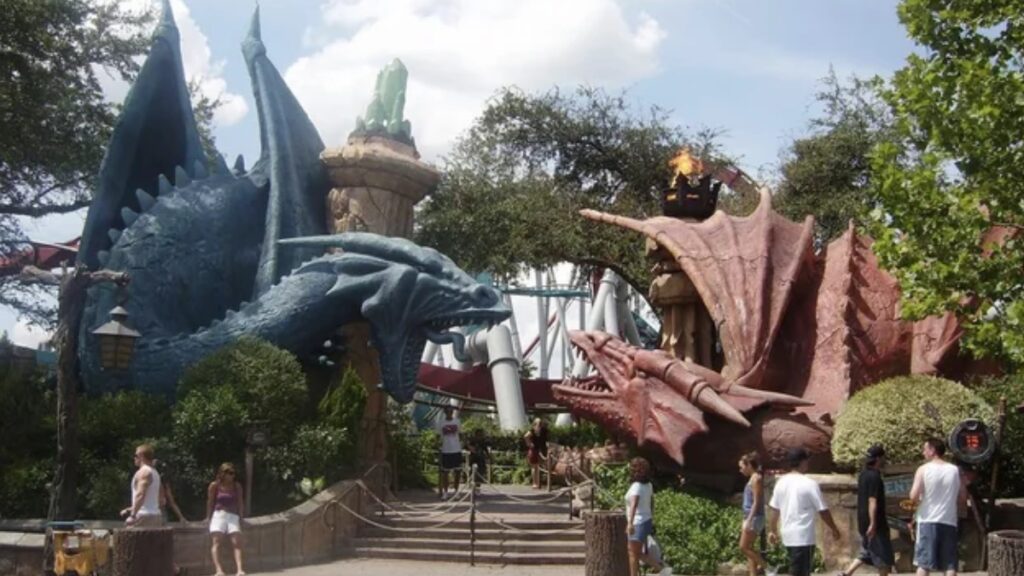
“Dragon’s Tower” becomes “Dueling Dragons”
Anywho, back to Islands of Adventure … is “Dueling Dragons” an obvious rip-off of “Beastly Kingdom”‘s proposed “Dragon’s Tower” ride? Perhaps. But how can you rip off something that hasn’t actually been built yet?
Some might argue that Universal — being the first theme park company to build a mega-coaster that featured a dragon storyline with a queue area that was themed around a decrepit castle — must now get credit for creating that attraction. Which means Universal effectively owns that ride idea. That would mean that — should Disney ever go forward with their “Dragon’s Tower” attraction idea — the Mouse would now appear to be copying ride ideas from Universal, rather than the other way around.
Never mind that Disney came up with the original idea for a dragon-based coaster. Never mind that Universal may have acquired the concept for their dragon coaster attraction under somewhat questionable circumstances. In the end, all that matters is: Who built the ride first? Since Universal was the first to build a dragon-based coaster, that ride concept now belongs to them.
“Beastly Kingdom” Loses Its Icon – Land Cancelled
And — since Eisner didn’t want it to appear as if Disney was stealing ride ideas from Universal — he asked the Imagineers to remove the “Dragon’s Tower” ride from all future plans for “Beastly Kingdom.” But — without the tumble-down burned-out castle (that would have served as “Dragon’s Tower”‘s show building) to serve as the centerpiece for this proposed addition to WDW’s fourth theme park — “Beastly Kingdom” was left without a “weenie,” a strong visual element that would lure people down into this side of the park. Without “Dragon’s Tower,” “Beastly Kingdom” now seemed kind of pointless.
Dinoland USA Expansion
As painful as it might be, Joe Rohde and his Imagineering team now had to face facts. “Beastly Kingdom” — as they had originally planned it — was dead. WDI would now have to abandon all the witty plans they’d come up with for this part of the park and dream up some new attractions for DAK’s east side.
Mind you, there was no time to mourn “Beastly Kingdom”‘s demise. Rohde and his team were too busy fighting with Disney management over their bargain basement expansion plans for DAK’s Dinoland USA. Assuming that — when Disney’s “Dinosaur” movie opens in theaters later this month — this side of the park will see a huge surge of new traffic, Eisner ordered that several lightly themed off-the-shelf carnival-style rides be added to Dinoland USA to increase capacity.
Rohde was said to be furious when he learned of this plan, particularly since WDI had already put together an elegant expansion plan for DAK’s dino area. He’s reportedly particularly enraged that the name that his Imagineering team came up with for a runaway-mine-car-through-an-abandoned-dinosaur-dig ride — the Excavator — for Dinoland USA’s “Phase II” will now be used for a smallish kiddie coaster Eisner is quickly tossing into the area.
Adding to Rohde’s aggravation: DAK’s ‘temporary’ area — Camp Minnie-Mickey — was becoming all the more permanent as each day went by. Exit polls showed that this area’s “Festival of the Lion King” show was the most popular attraction in all of Animal Kingdom. So popular that Disney had to add additional seats to DAK’s “Lion King” theater to increase the show’s capacity. And — with “Lion King III,” another direct-to-video sequel to the original 1994 film, currently in the works — it could now be years before the “Lion King” phenomenon finally fades … leaving all the land around that once-thought-to-be-temporary theater available again for development.
As you can see, Rohde and his Imagineers didn’t have time to moan over “Beastly Kingdom”‘s loss. They’re too busy fighting with Disney Company management, trying to keep Eisner and Co. from ruining the park with their bone-headed cost-cutting maneuvers.
Editor’s Note: This article is an adaptation of the original three-part series from Jim Hill Media, “Is DAK’s Beastly Kingdom DOA?” (December 2000). Pandora – The World of Avatar officially opened at Disney’s Animal Kingdom on May 27, 2017, in the area originally proposed for Beastly Kingdom.
Will There Ever Be a “Beastly Kingdom” at Walt Disney World?
But is “Beastly Kingdom” really dead? At least for the immediate future, it would seem so. Any ambitious plans the Mouse may have had for expansion of Disney’s Animal Kingdom are now completely on hold.
Why for? Because there’s so much other stuff at DAK that’s currently in urgent need of repair. For example: Conservation Station is thought to be a complete disaster. Visitors repeatedly name that area as their least favorite part of Disney’s Animal Kingdom. So the Imagineers are frantically searching for ways to fix up that facility.
And then there’s Kali River Rapids. Though only a year old, the centerpiece attraction for DAK’s Asia area is already falling apart. There are currently so few of that attraction’s original rafts in working condition that visitors often have to wait as much as an hour in line before there’s a raft available for them to board.
But all those Disney unicorn and dragon lovers out there shouldn’t completely lose heart. Long-time Disney theme park observers know it’s wise never to consider a really great concept for a theme park show or attraction completely dead. For the Imagineers have this awful tendency to recycle abandoned ideas.
Consider Disneyland’s long proposed Discovery Bay. Though Tony Baxter hatched the concept for this Jules Verne-meets-Gold Rush-era-San-Francisco Frontierland expansion back in 1977, it wasn’t until 1992 that elements of this proposed Disneyland addition finally turned up in a Disney theme park. Unfortunately for all those US-based Discovery Bay fans, the park that got the land (DiscoveryLand, to be exact) that was inspired by Tony’s concept art was Disneyland – Paris. But some of Discovery Bay did finally make it off the drawing board.
So who knows? Maybe in ten years or so, some Imagineer may come with a clever way to rework the “Dragon’s Tower” storyline. Perhaps that long rumored South American Disney theme park will have a Sleeping Beauty’s castle with a thrill ride — rather than a walking tour — as its main attraction? Maybe this thrill ride will feature a huge AA version of the Maleficent dragon, snarling and breathing fire at riders as they whiz through the attraction’s finale? Stranger things have happened, kids.
Here’s hoping that — some day, in some way — dragons and unicorns turn up in a Disney theme park.
After all, there’s always room for a little more magic in the Magic Kingdom.
Want more behind-the-scenes Disney stories? Dive deeper into the magic with The Disney Dish podcast, where Jim Hill and Len Testa explore Disney news and park history. Listen now at The Disney Dish on Apple Podcasts. For exclusive bonus episodes and even more insider content, check out Disney Unpacked on Patreon.
Television & Shows
The Untold Story of Super Soap Weekend at Disney-MGM Studios: How Daytime TV Took Over the Parks

A long time ago in a galaxy that … Well, to be honest, wasn’t all that far away. This was down in Florida after all. But if you traveled to the WDW Resort, you could then experience “Star Wars Weekends.” Which ran seasonally at Disney’s Hollywood Studios Disney World from 1997 to 2015.
Mind you, what most folks don’t remember is the annual event that effectively plowed the road for “Star Wars Weekends.” Which was “Super Soap Weekend.” That seasonal offering — which allowed ABC soap fans to get up-close with their favorite performers from “All My Children,” “General Hospital,” “One Life to Live” and “Port Charles” — debuted at that same theme park the year previous (1996).
So how did this weekend-long celebration of daytime drama (which drew tens of thousands of people to Orlando every Fall for 15 years straight) come to be?
Michael Eisner’s Daytime TV Origins and a Theme Park Vision
Super Soap Weekend was the brainchild of then-Disney CEO Michael Eisner. His career in media began with short stints at NBC and CBS, but it truly took off in 1964 when he joined ABC as the assistant to Leonard Goldberg, who was the network’s national programming director at the time.
Eisner quickly advanced through the ranks. By 1971, he had become Vice President of Daytime Programming at ABC. That meant he was on the scene when One Life to Live joined the lineup in July 1968 and when All My Children made its debut in January 1970. Even after being promoted to Senior Vice President of Prime Time Programming in 1976, Eisner stayed close to the daytime division and often recruited standout soap talent for ABC’s primetime shows.
Fast forward nearly two decades to July 31, 1995. The Walt Disney Company announced that it would acquire ABC/Cap Cities in a $19 billion deal. Although the acquisition wasn’t finalized until February 1996, Eisner was already thinking ahead. He wanted to use the stars of All My Children, One Life to Live, and General Hospital to draw people to Disney’s theme parks.
He had seen how individual soap stars were drawing huge mall crowds across America since the late 1970s. Now he wanted to bring dozens of them together for something much bigger.

Super Soap Weekend Takes Over Disney-MGM Studios
The very first Super Soap Weekend was announced in June 1996, just a few months after the ABC deal closed. The event was scheduled for October 19 and 20 at Disney-MGM Studios and was a massive success.
The weekend featured panel discussions, autograph sessions, and photo opportunities with the stars of ABC’s daytime dramas. Thousands of fans packed the park for the chance to meet their favorite actors. Due to the overwhelming response, the event became an annual tradition and was eventually moved to Veterans Day weekend each November to better accommodate attendees.
Longtime fans like Nancy Stadler, her mom Mary, and their close friend Angela Ragno returned year after year, making the event a personal tradition and building lifelong memories.

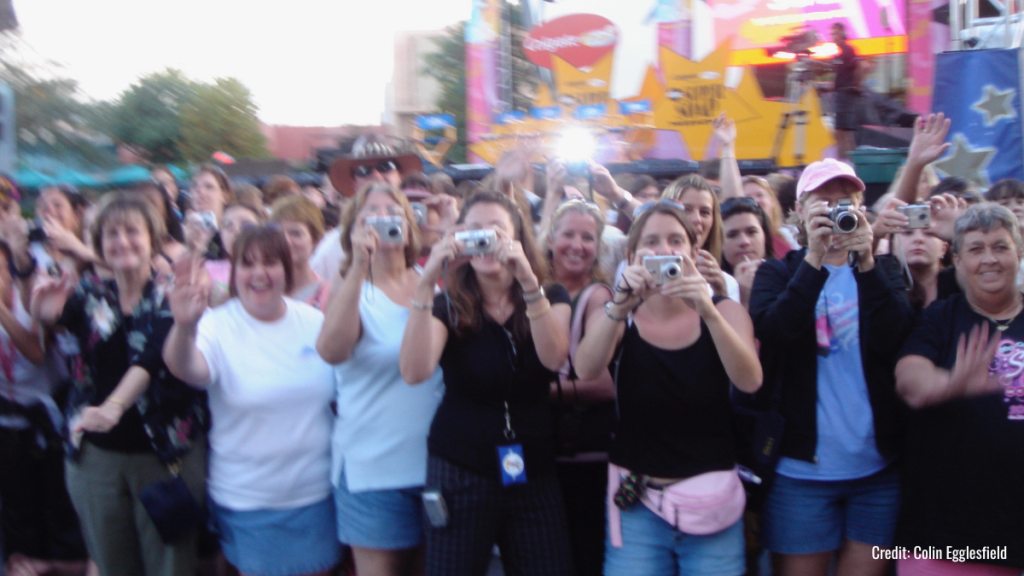
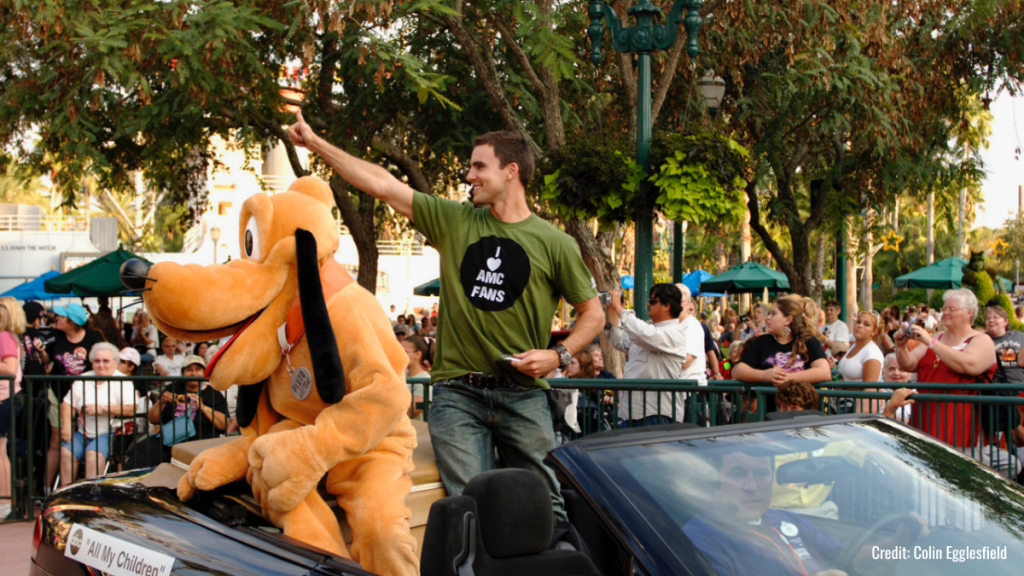
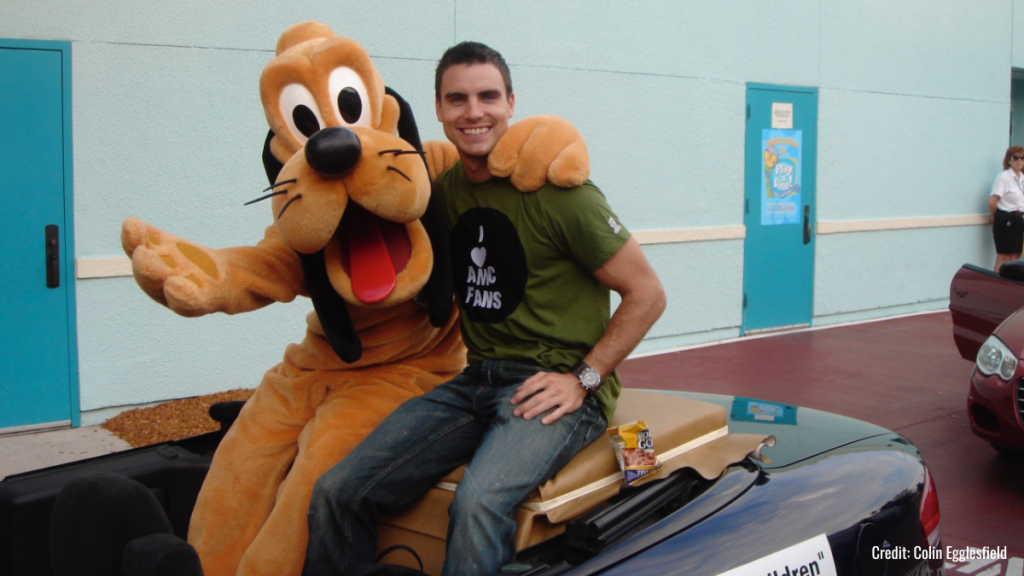
West Coast Events and the ABC Soap Opera Bistro
Disney even tried to recreate the event out west. Two Super Soap Weekends were held at Disneyland Resort, one in April 2002 and another in June 2003.
At Disney’s California Adventure, Eisner also introduced the ABC Soap Opera Bistro, a themed dining experience that opened in February 2001. Guests could dine inside recreated sets from shows like General Hospital and All My Children, including Kelly’s Diner and the Chandler Mansion. The Bistro closed in November 2002, but for fans, it offered a rare opportunity to step into the world of their favorite soaps.
SOAPnet, Port Charles, and the Expansion of Daytime TV at Disney
Eisner’s enthusiasm for soaps extended beyond the parks. In January 2000, he launched SOAPnet, a cable channel dedicated to prime time replays of ABC’s daytime dramas.
During his time at Disney, General Hospital also received a spin-off series titled Port Charles, which aired from June 1997 to October 2003. The show leaned into supernatural plotlines and was another example of Eisner’s commitment to evolving and expanding the soap genre.
The Final Curtain for Super Soap Weekend
In September 2005, Eisner stepped down after 21 years as head of The Walt Disney Company. Bob Iger, who had previously served as President of ABC and Chief Operating Officer of ABC/Cap Cities, took over as CEO. While Iger had deep ABC credentials, he didn’t share Eisner’s passion for daytime television.
In the fall of 2008, Disney hosted the final Super Soap Weekend at what was then still called Disney-MGM Studios. That same year, the park was rebranded as Disney’s Hollywood Studios, and Disney began shifting away from television-focused experiences.
Within the next five years, the rest of Eisner’s soap legacy faded. One Life to Live was canceled in January 2012. SOAPnet was rebranded as Disney Junior in February 2013. Later that year, All My Children ended its 41-year run on ABC.
Only General Hospital remains on the network today, the last standing soap from the golden age of ABC Daytime.
A New Chapter for Daytime TV and Super Soap Fans
The soap genre may have faded from its former glory, but it’s not gone. On February 24, 2025, CBS premiered a brand-new daytime drama called Beyond the Gates, marking the first new soap launch in years.
Meanwhile, All My Children alum Kelly Ripa has been actively working on a revival. In September 2024, she mentioned a holiday-themed movie set in Pine Valley that would bring back many original cast members. The project was in development for Lifetime, though its current status is unclear.
And what about Super Soap? Fans like Nancy and Angela still hope Disney will bring it back. Even if it only featured the cast of General Hospital, it would be a welcome return for longtime viewers who miss that one weekend a year where the magic of Disney collided with the drama of daytime TV.
If you want to hear firsthand what it was like to be part of Super Soap Weekend, be sure to listen to our I Want That Too podcast interview with actor Colin Egglesfield. He shares behind-the-scenes memories from his days as Josh Madden on All My Children and what it meant to be part of one of the most unique fan events in Disney park history.
-

 Theme Parks & Themed Entertainment10 months ago
Theme Parks & Themed Entertainment10 months agoDisney’s Forgotten Halloween Event: The Original Little Monsters on Main Street
-

 Theme Parks & Themed Entertainment10 months ago
Theme Parks & Themed Entertainment10 months agoThe Story of Mickey’s Not-So-Scary Halloween Party: From One Night to a Halloween Family Tradition
-

 Film & Movies10 months ago
Film & Movies10 months agoHow “An American Tail” Led to Disney’s “Hocus Pocus”
-

 Theme Parks & Themed Entertainment8 months ago
Theme Parks & Themed Entertainment8 months agoDisney and Macy’s 90-Year Thanksgiving Day Parade Partnership: From Mickey’s First Balloon to Minnie’s Big Debut
-

 Television & Shows6 months ago
Television & Shows6 months agoHow the Creators of South Park Tricked A-List Celebrities to Roast Universal – “Your Studio & You”
-
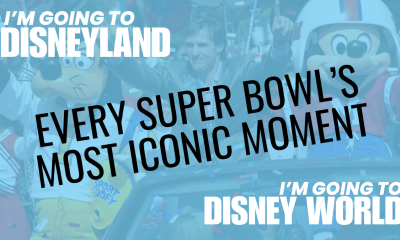
 History5 months ago
History5 months agoThe Super Bowl & Disney: The Untold Story Behind ‘I’m Going to Disneyland!’
-
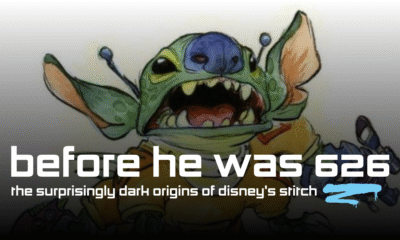
 Film & Movies2 months ago
Film & Movies2 months agoBefore He Was 626: The Surprisingly Dark Origins of Disney’s Stitch
-
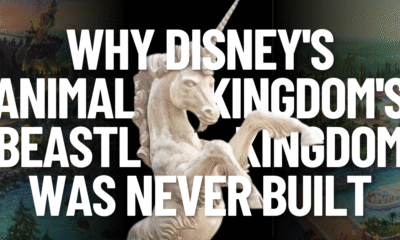
 History1 month ago
History1 month agoWhy Disney’s Animal Kingdom’s Beastly Kingdom Was Never Built








